
Sue's Coeliac diary
In 2008 Sue was diagnosed with Coeliac Disease although, as she says, who knows how long she had actually suffered from the condition.
FoodsMatter first met her soon after she was diagnosed and was desperate to find some gluten free foods that she actually wanted to eat. She joined our tasting panels and for four years, from 2014-8, she wrote us regular diary pieces about her life as a coeliac.
"I love to eat – but my day job is a camera woman working mainly on location, so eating gluten free can be a challenge....
Other salient facts:
I used to have the London School of Tropical Medicine on speed dial
I have had Campylobacter in Timbuktu, Katmandu and Bigbury-on-Sea.
Once I took sandwiches to a funeral. I'm always worried I won't have enough to eat. This is my diary...
10th August 2018: The bloody kitchen
14th April 2018: Unfairness
16th February 2018: It’s unusual to have such an unexpected display of solidarity. My friends look down at my plate and erupt with indignation.
January 2018: Zoats – and yellow stickers....
October 2017: Jacket potatoes – the way to my heart....
August 2017: Gluten and campervans just do not mix
March 2917: A paean to clean eating
January 2017: Gluten-free beer drinking in 2017
November 2016: It's been a mad week...
September 2016: Being barred from the table: the emotional fallout
August 2016: Negotiating toxins
July 2016: Bread....
May 2016: Filming in deepest Africa
March 2016: River Cottage Goes Gluten-Free (for an evening with Naomi Devlin)
March 2016: All I (don’t) Need Is The Air That I Breathe
February 2016: The FreeFrom Food Awards
January 2016: What do dhal baht and Vi
valdi have in common? They can turn a vituperative coeliac into a happy human being.
December 2015: Indigo – the perfect allergen-free evening
November 2015: Caterers are learning... slowly....
October 2015: Veggie sausage tasting!
September 2015: Feeling dull and boring? Dissatisfied with life?
August 2015: Gluten-free shopping on a budget
July 2015: The perils of takeaways
June 2015: The big black marker
May 2015: Sue runs a tutored tasting of gluten-free beer
April 2015: Women's Institute teas - a much valued institution but.... Beware if you are on any kind of restricted diet!
March 2015 A strange inheritance – muesli and kefir...
February 2015 If you need a friend
January 2015 Bread!
January 2015 Run down on 2014...
November 2014 Are we being too optimistic about freefrom food?
October 2014 We’re trying to work out how much gluten’s in my lunch but all I really want to do is eat it.
September 2014 Packing for the hols
August 2014 Could eating out become a pleasure rather than a pain?...
July 2014 The Marmite issue
June 2014 Feast or famine? Sometimes we all get it wrong.
May 2014 Share my food? No way...
May 2014 Guests mean gluten.....
April 2014 Beer fest.......
March 2014 Coeliac tool kit....
March 2014 Being diagnosed with coeliac disease
NB. If you would like to comment on any of Sue's diary entries, please email your comment to us and we will upload it.
10th August 2018
The bloody kitchen.....
“What’s the worst thing about living with a coeliac?”, I asked my other half whilst we were lying in bed one morning.
“The bloody kitchen,” he cried, sitting up. “It’s a nightmare. We need separate ones.”
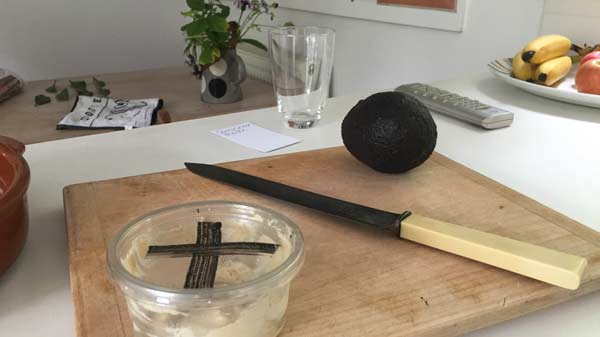
“Oh dear,” I said, only half listening.
“It’s everything,” he shouted, stomping around the room to pick up his socks. “Cross-contamination. It’s not funny. Dishcloths. Worktops. Breads. Drawers. Cupboards. It’s terrible. It’s ruining my life.” A long litany of complaint ensued, followed by “My next girlfriend will be someone who doesn’t have CD.”
I don’t spare much thought for the flip side of coeliac disease – what it’s like to live with someone else’s dietary restriction that encompasses all the foods you want to eat, namely bread, beer, pasta, chips. I was surprised to hear that it’s actually the kitchen that’s perceived to be the worst thing, rather than the other effects it has on your life.
In the case above, the previous three days might have had something to do with J’s heart-felt complaint. He’d been in sole charge of a guest and all the gluten in the world, most of which appeared to be in our kitchen. Plus he’d inadvertently purchased a large sliced-loaf of very crumbly gluten-bread, which deposited a thick layer of breadcrumbs over everything each time the bag was opened.
He was on such high alert that our meal-time conversation was punctuated by cries of “No, stop!” whenever jars were opened without spoons in hand, or the cheese even looked at by the guest wielding the bready knife.
Since then, my experience catering for friends with exclusion diets has made me more aware of just what a pain it is to deal with a special diet in which you are not personally invested. Who knew it was so hard?
I struggle with diets that can seemingly change on a whim. I know CD appears complicated to the uninitiated but at least it’s set in stone. If you’re following the diet you simply avoid gluten, none of this “Well I should really avoid tomatoes but a few won’t hurt,” – especially when you’re sitting at table looking down at an individual tomato-free lasagne.
Or claiming you’re “Practically vegan,” saying “Oh no, butter’s alright,” and then having milk in your tea. Ditto anchovies when you don’t eat fish, or sugar when that’s banned, and going out to a café and stuffing your face with cake.
In theory strict diets are OK because you know what you have to avoid. Some diets are more variable, but when you have to Google every ingredient to make sure a meal will be OK - even teeny quantities of each spice you want to use, it’s annoying to find out afterwards you went to a load of needless trouble.
I cooked for a FODMAP friend recently and took great care to make a meal I was absolutely sure was safe, but when he walked in he said airily “Oh no, you shouldn’t have bothered, I eat garlic, yoghourt and milk.”
After being thrown into a world of diets which are not like mine, and having briefly viewed things from the other side of the fence, I have a lot more sympathy for the allergy/intolerance mums, dads, sisters and boyfriends who accommodate people with CD into their daily lives. To my long-suffering friends and partner, who always cater for me safely and inventively with never a dish I can’t eat – a new respect, thank you.
As for what it’s like actually living with a coeliac and sharing the kitchen with a culinary alien, I don’t really want to think about that. If the tables were turned I don’t believe I’d be too happy either and would probably be moaning about dishcloths myself.
14th April 2018
Unfairness.....
I am standing in the kitchen wondering what to make for supper.
My partner has been to the dentist. He walks in glumly bearing a small carrier bag full of spreadsheets, instructions and drugs, and places it in the middle of the worktop. He gives a weird, lopsided grimace and heads straight for the living room sofa. I catch sight of him attempting to cover himself up with a blanket.
A feeble voice comes from the other room, ‘I think I can only manage soup’.
‘OK’, I reply, ‘I’ll make it’.
The only available supper is leftover bean-stew from the night before, the remains of which he is proposing I make into soup.
My mind is inextricably drawn to the pizza base lurking in my cupboard that needs eating. I know in my heart that this idea is not a good one, but then I think of the times I go out to a café with my partner when there is nothing for me and he tucks into a cake or a pasty without a hint of shame, and the idea suddenly grows in attractiveness.
I decide to make the pizza thinking it will show him what it’s like to be coeliac when your partner is selfish and eats in front of you all the time and how it would be much nicer and more polite to wait until you can both enjoy some food. I do not consider how he will understand any of this.
It takes longer than I imagine to prepare all the toppings, and I squander precious time looking around for the jar opener for the artichoke hearts - which I eventually find under the stairs, lodged for no apparent reason in between an electrical socket and the burglar alarm.
My partner lies quietly on the sofa with his hood up, waiting for the soup.
After I put my pizza - a splendid-looking creation with artichoke hearts, anchovies, capers, olives, and embellished with wild garlic - in the oven, I take the cutlery through to the living room and lay the table.
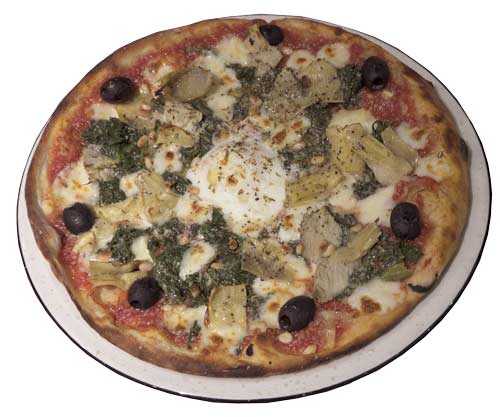
I decide it might be best to mention the pizza before I bring it in.
‘I’m having pizza’, I say nonchalantly.
There is a stunned silence during which the shape on the sofa processes the unfairness. I disappear swiftly to the kitchen.
Ten minutes later I walk back in. The shape turns to face me.
‘I can’t believe you did that,’ he says.
I put my cold beer and green salad on the table and realise there is no avoiding the car crash that is about to happen. I feel slightly ashamed and get the soup.
My pizza is so large I decide that it’s probably better if I just bring in half to start with. I cut it up and notice it doesn’t look quite as attractive as I previously thought. The soup has been boiling for a while and does not look good either.
I carry through his small bowl and my large plate and we sit across the table from each other staring at our meal, each locked in our own private world of unfairness.
‘There’s too much cheese on that pizza you know’, he says.
16th February 2018
 It’s unusual to have such an unexpected display of solidarity. My friends look down at my plate and erupt with indignation. It’s unusual to have such an unexpected display of solidarity. My friends look down at my plate and erupt with indignation.
It’s a cold winter evening and we’re going out for supper. We have agreed to meet our friends outside the chip shop on a wind-swept corner on the worst side of town.
We are early and they are late. We spot them driving into town before they send us a text saying ‘In the nearest pub if you want to join us.’
Sick of waiting on the corner for them at the allotted time, wearing unsuitable clothing in sub-zero temperatures, we go inside our restaurant and sit down. Our friends don’t know where we’re eating.
The restaurant is a single room sandwiched between the chip shop that used to be a dog launderette on one side, and a tattoo parlour on the other.
The chip shop is getting ready for business and there is a large queue forming inside. I’m worried that our friends will think it’s the supper destination, so I keep having to nip outside to check if they’re there. It’s very cold on the street corner, and I can’t wait long before having to dive back inside.
There is something post-apocalyptic about the décor in our restaurant that does not marry well with the extremely low temperature. Our friends finally arrive, take their coats off and put them straight back on again.
If you were to turn up with no knowledge that this place was renowned for its food you would be excused for walking out again thinking you’d got the wrong address. It’s dark inside and is painted black.
We’d booked the week before, three times confirming I had CD. When our food comes I’m a little miffed to see everyone else tucking into a first course of a warm wheaten-dumpling, stuffed with ox-tongue and accompanied by hoisin sauce, whilst I look down at a tiny bowl of crisps.
Putting on an I’m-not-disappointed-at-all face, I taste one of the wafers of deep-fried Jerusalem artichoke and feel my expression change to one of smugness, which I hastily cover up in case anyone decides they’d like to try one. My friends are too busy mooning over their ox tongue and slurping wine to notice. I spot my friend surreptitiously zipping up his down jacket.
Two courses later the others are presented with plates of hake and beurre blanc served under a slice of bread, accompanied by a platter of bread to share. I just have fish. My friends look down at my plate and then up to my face with a barely disguised expression of indignation on my behalf.
They are outraged I haven’t also been provided with a slice of bread, and although I point out that my piece of fish is actually larger, they give voice to their complaint at considerable length. I am not terribly concerned because this is a daily event in the life of a coeliac and sick of their moaning, tell them to shut up.
As time passes and we became colder during the long wait between courses, there is plenty of opportunity for the bread situation to raise its head again, which it does with wearying regularity. Our conversation is punctuated by the momentary distraction of each new dish, after which the subject of the lack of GF bread returns to fully occupy the mind of the other three.
Strangely, given that they normally roll their eyes with scarcely disguised boredom whenever the subject of gluten arises, one of them is so angry about my perceived mal-treatment he stands up and says, ‘I’m going to have it out with them.’ I protest. Between them they unanimously agree that having booked a week ago, the restaurant should have had some GF bread in the freezer to serve in such circumstances.
I am not greatly bothered, feeling both well-fed and quite keen to get home to the fire, so I attempt a surprisingly well-argued defence of the restaurant, but as time runs on I begin to feel quite chuffed by their indignation and by the next morning, when the issue again becomes the topic of our breakfast discussion, I am actually feeling quite puffed up by this unlikely display of solidarity over the perceived injustice of a missing slice of sourdough.
Share your coeliac dining-experiences with us @coeliacsmatter
6th January 2018
Zoats – and yellow stickers....
Today I had to look up zoats.
No, me neither – it’s actually porridge made from oats and bits of courgette should you feel the need.
Not knowing that zoats is a thing and that maybe I should be eating it and posting pictures of it made me feel well … pretty mediocre, because suffice to say the diet I follow at the moment consists of the type of food you wouldn’t want see on Instagram.
I knew things were bad at some point during the last week when I actually raised myself from the sofa and I went to the kitchen to look for something healthy to eat.
There wasn’t anything. Everything was beige, brown and greasy, mostly bearing a reduced-price label.
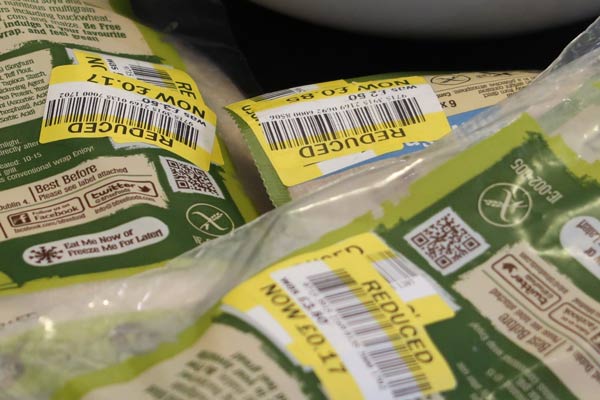
In fact, over the previous three days I’d consumed nothing remotely healthy at all and had spent most of my time reclining on the sofa eating pastry.
You see it’s not entirely my fault I ate nineteen mince pies in three days. It’s because of my freezer full of bargain items that needed to be eaten. My addiction to the yellow-sticker method of shopping means that I simply cannot pass the reduced shelf in the supermarket without having a quick peek to see if there’s anything gluten free.
Spotting a reduced pack of gluten-free pastry on that shelf feels like winning the lottery, only better. Finding anything that’s cheap is extraordinarily exciting for coeliacs. The whole world is normally against us, what with over-priced food and never any choice, so when you spot something that usually costs four times more knocked down to 99p, even if you’d never normally have bought it, you walk out of that shop feeling that maybe life isn’t too bad after all, and skip happily home with a nice warm feeling of success.
But I’ve come to see that although yellow-sticker items do bring periodic moments of joy if you come across them only occasionally, buying every single one you see and then having to eat it is a compulsion that’s best avoided. I’ve got to kick my habit.
I must admit I don’t much like rooting through the back of the reduced-item shelf in the supermarket where my nicely-dressed neighbours can see me on their way to the finest-examples-of-very-expensive-food shelf, but I feel compelled to do it on the off-chance there might be a nice loaf of gluten-free bread flaunting itself at me.
The truth is that there sometimes is some form of gluten-free carbohydrate in there, but rarely anything I’d actually want to buy full price. I might not even like most of it. I crave the idea and purchase items with serial optimism but when I get them home I realise that I’ve been lured by the excitement of the yellow stickers and I swear I’ll never do it again.
But even though I don’t understand the attraction of wraps, my freezer is still bursting with frisbee-sized packets reduced to twenty pence, ditto random bread, bagels and crumpets, every one adorned with bursts of yellow.
All the beige and brown food in plastic bags somehow has to go. The tyranny of the compulsive purchase and the frenzied consumption is weighing heavy on my shoulders. I did enjoy the mince-pie marathon, although I do admit to being slightly ashamed I ate them so quickly and refused to share them with any another living person.
This year I’m going to try to stay clear of that force-field of yellow stickers. I’m not going to let my eyes rest on the alluring shape of the shelf as I shuffle past in the supermarket.
Zoats still might not be on the menu, but I’m just going to buy the food I actually want to eat, chosen for the right reasons. In a way that will be one mediocre coeliac’s victory against the world.
6th October 2017
Jacket potatoes – the way to my heart....
I come from a household where the jacket-potato had the status of a super star. Not the sweaty, microwave-potato you get in places where there’s nothing for coeliacs to eat, but the oven-baked, made-at-home variety, skin dark and crisp, inside velvety and golden with butter.
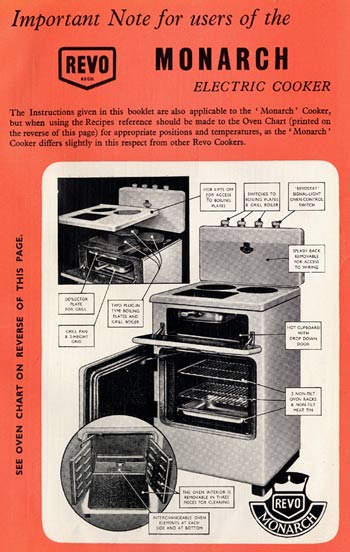 My father’s 1950s cooker, with its row of fluted knobs like crowns along the top, two rings and cast-iron griddle-plate, had an unreliable oven due to the failure, sometime in the early 1970s, of the right hand element. A new part proved impossible to find and, not be defeated by a minor inconvenience when the rest of the cooker was working perfectly well, my father used it for the next forty years with only the left side heating up. My father’s 1950s cooker, with its row of fluted knobs like crowns along the top, two rings and cast-iron griddle-plate, had an unreliable oven due to the failure, sometime in the early 1970s, of the right hand element. A new part proved impossible to find and, not be defeated by a minor inconvenience when the rest of the cooker was working perfectly well, my father used it for the next forty years with only the left side heating up.
It didn’t matter much because the oven was only used for the bi-monthly baking of bread, a process that actually took so long that by the time the three tins of 100% rye eventually made it to the oven, the temperature had finally reached 450°F on the long brass thermometer he inserted to check.
Jacket potatoes were the happy by product of each of my father’s bread-making days….but these were not just any old jacket potatoes.
Their inclusion in what was a whole day of cooking started from the imperative of filling the oven if it was on. The ancient, leaky cooker took so long to heat and the bread so long to rise that it was almost always suppertime before all the baking was done, and what better than to have a ready meal at the end of it.
My father liked his jacket potatoes more than any other food, and even though I always groaned with sophistication and rolled my eyes at their mention, they tasted pretty good.
The potatoes were put in the oven with the bread and cooked until their skin was crisp and dark brown. After an hour or so they were removed - a difficult procedure because opening the door wide enough to retrieve anything from the oven was hampered by the location of a small white chest of drawers which, for some inexplicable reason, lived in front of it.
Our thick, creamy oven-cloth was always a little too small to hold the hot potatoes, and there would be cries of “Damnation,” and “Oh blast,” as they came out, juggled from hand to hand until they were tossed onto the white Formica top.
Every morsel of fluffy inside was scooped out and placed in a bowl with butter, copious amounts of grated Canadian-cheddar, and ‘salt and pepper’ - this was a time when these last two ingredients on their own were considered sufficient seasoning.
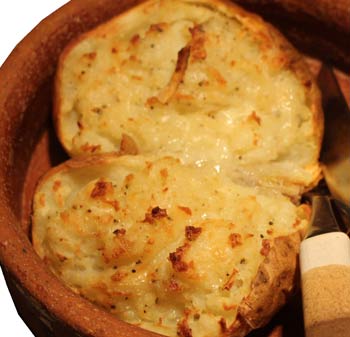 By now the white enamelled-sink and drainer was a tower of utensils ready to be washed-up. The soft, cheesy potato was carefully replaced in the lined-up potato skins and their surface neatly forked into ridges. By now the white enamelled-sink and drainer was a tower of utensils ready to be washed-up. The soft, cheesy potato was carefully replaced in the lined-up potato skins and their surface neatly forked into ridges.
Next the ancient grill was switched on, plates put on the top to warm and the stuffed potatoes grilled until the insides were bubbling hot, their fine ridges crisped and brown.
My father took off his bread-covered apron, placed his supper on an extremely hot stoneware-plate, and finally sat down at the kitchen table to enjoy the feast.
It can be outshone in glory by a more complicated dish, but a jacket potato is the most comforting of foods. There’s nothing simpler to make or, in my humble opinion, more satisfying. Fill your oven with them for me when I come round and there will be no happier coeliac.
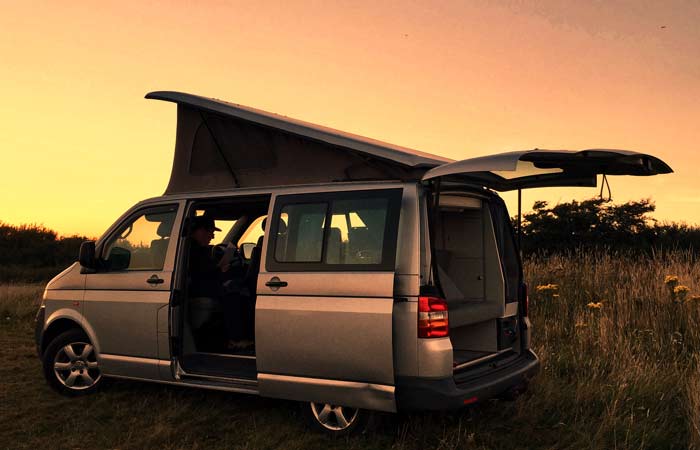
4th August 2017
Gluten and campervans just do not mix.
Think about it before buying one if you have long harboured a dream of carefree times hanging out in a pop top with friends.
Mine is now officially designated a PGFZ (protected GF zone) and I’m adamant that not a single crumb of gluten is coming through its doors again, even post Brexit.
I love our campervan and wild camping, waking up with the sound of the sea crashing on the rocks, or the view of mountains as far as the eye can see, but I’ve had enough of trying to share a small space with another human being hell bent on feasting on the very thing that makes me sick.
Gluten spoils all the special fun that is the whole point of having a campervan. Parked up in front of a spectacular sunset with the roof up and a cool breeze wafting across the cushions where you’re reclining with a book, occasionally looking up to check the view and smile with the happiness of it all, you climb down to make a cup of tea and a snack and realise there is a whole gluten-war going on in the square foot of Formica that is ‘the worktop’ and everything that should be safe and reliable has been upturned with a klaxon going off in your head screaming ‘DANGER, DANGER’.
I’m sick of finding crumbs from bread rolls and muesli flakes everywhere. I’m sick of picking up the sharp knife and realising it’s got gluten all over it, reaching for the dishcloth and then realising there’s gluten all over that AS WELL. Somehow the very freedom and joy a campervan confers is wiped out in an instant by the difficulty of managing food in that very tiny space. Something has snapped inside me and I’ve waved goodbye to gluten in that van.
We discussed it all after we’d come home 2 trips ago, and J had seen how gluten, a coeliac partner, and a campervan were simply not a successful combination. He even suggested he might try being GF in the van on our next trip and actually said he’d give GF muesli a second go.
(About a million years ago J had a bad experience with my GF muesli and was so traumatised he has refused to try it ever since. I agree that it can’t have been pleasant eating a clump of damp maca-root powder hidden in an innocent-looking bowl of muesli, and that publicly spitting it out at a pleasant breakfast-table overlooking the Mediterranean was not an ideal way to meet relatives for the first time, but shit happens and you just have to move on.)
Of course by the time of our next trip all those good intentions were forgotten, and there was wheat muesli all over the worktop again and battered-looking paper bags containing bread rolls and all manner of gluten delicacies stuffed into every available orifice in the van. Suffice to say it was not a good time.
But now things have changed. I’ve been away with another friend who actually didn’t find it a chore to avoid gluten for a day or two. So I’ve put my foot down and for the sake of my health (both mental as well as physical) I’ve declared it a GF campervan and everyone else can like it or lump it. Goodbye gluten, and hello stress-free weekends away. It can’t be that hard to give up gluten for a few days can it?
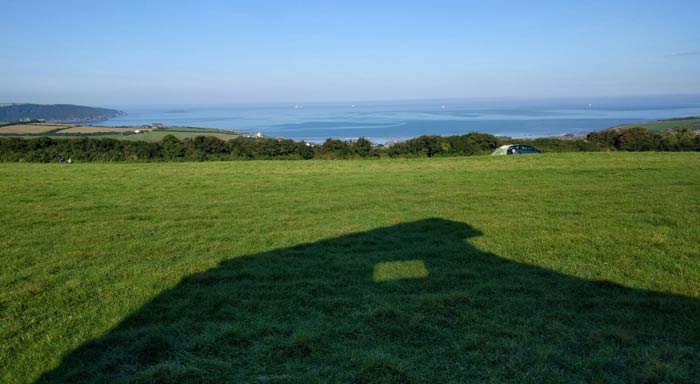
4th March 2017
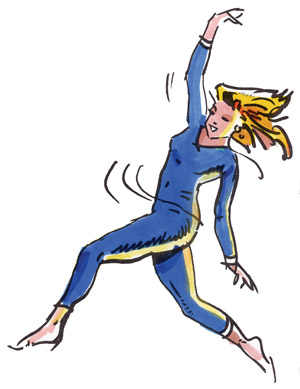
Clean eating might be in the news for all the wrong reasons, but I revel in its popularity. I secretly love the wellness trend and the way its health-obsessed devotees have nudged the gluten-free market into flower with a brilliance that seems nothing short of a miracle.
Healthy eating is hip, and if that means less gluten and dairy, that’s fine by me. Fine too if there’s less meat and sugar. Paleo, vegan, bring it all on. The more the mainstream sees gluten and everything else as the devil’s food, the more coeliacs can eat.
Sometimes I almost catch myself feeling a little, well, disappointed. Supermarket shopping doesn’t seem quite the same as it used to be - always that tiny bit depressing, fighting for elbow-room in a world full of gluten, feeling a tad resentful. Maybe the battle has moved on.
The FF section in my tiny Tesco has suddenly blossomed. Seemingly overnight it’s grown from a couple of shelves to linear metres of FF food. I’m not sure what I’d do if I ever found myself in a large store. I might pass out with shock.
The coeliac market alone is too small to have more than a tiny effect on the offerings from major supermarkets. But the clean-eating, health-driven food trend is large and still growing. In a YouGov sample of 1067 adults in 2016, a fifth were cutting down on gluten and/or dairy and half of these made the change as part of a conscious effort to eat more healthily. Products without artificial ingredients, that were naturally gluten-free, with additional protein, were seen as the most appealing. Who am I to argue with these choices?
I love the elective excluders who have rid their lives of gluten and other allergens. They’ve filled the shops with food I can actually eat, and might even want to buy. I don’t pity their depleted diets or worry they’re missing minerals. I’m just grateful for their obsession with wellness and health, a trend that has driven the FF market to the massive £627m that it was in 2016.
So I inwardly smile with gratitude when I see yet another photo of *#avotoast!* and #smoothiebowl!* because I know it’s evidence that the clean-eating food warriors are still doing their work. I’m freewheeling on the back of a food trend that’s going faster and faster. Please don’t let it end.
Without the market-shaping demands of these food avoiders, the new products in our shopping trolleys today would be very different. Cereals without sugar? No chance. No healthy ready-meals. No chia porridge-pots, quinoa puffs or seaweed noodles. No racks of energy bars, crackers, or raw chocolate tarts, every single one of them something a coeliac can eat.
So thank you beautiful wellness-people, you lucky shoppers who can eat anything but choose not to. Thank you for your dietary deprivation and your devotion to the cause of clean eating. It has transformed my life.
8th January 2017
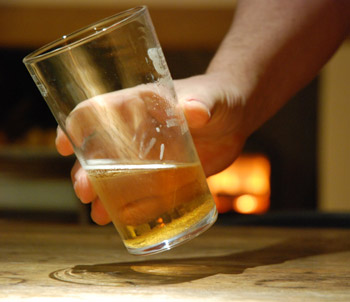 If you love a pint but worry about drinking beer made from one of the very grains that are toxic to coeliacs, then 2017 could be your year. If you love a pint but worry about drinking beer made from one of the very grains that are toxic to coeliacs, then 2017 could be your year.
A whole new range of naturally-GF beer is about to hit the market and there’s not a grain of barley in any of it. Rice, quinoa, millet and sorghum give these bottles their malted sweetness, a careful blend of hops their aroma and bitterness. Made in small batches by innovative brewers, they fit in perfectly with the range of craft beer we’re all going mad for at the moment.
Developments in brewing technology mean there’s now no shortage of beer which is declared GF yet is made from barley. It might not be quite so easy to find in a pub, but online there’s anything from lager to English ale and stout, brewed in the normal way from malt, usually treated with an enzyme which breaks down the barley protein so tests can’t quantify it.
It tastes just like normal beer – indeed it’s often identical to normal beer as the enzyme is commonly used by brewers for other reasons. The GF status it confers is just an accidental side effect on which savvy brewers have been happy to capitalise, much to our benefit.
But what happens if you’re a coeliac who reacts to these GF beers made with barley, or if you simply don’t like the idea of drinking something containing the very substance you’re meant to avoid? You might be a coeliac who was asymptomatic before diagnosis – someone whose anaemia, for example, was the only evidence of the disease. How safe is it in this instance to rely on an adverse reaction as an indicator of damage being done?
Ten years ago naturally-GF beer was an early experiment with non-gluten containing grains - a strange quasi-medicinal brew that even the most committed beer drinker found it hard to love. Pitching to a limited market and subsequently side-lined by the explosion of GF beer made using barley over the next few years, naturally-GF beer fell out of favour and has been increasingly hard to find.
But 2017 promises to be the year it reappears with a flourish. Green's, the country’s largest and most established GF-brewer, is launching a new range made from non-gluten-containing grains, and there are naturally-GF products from Autumn Brewing and Quinoa Italia, both newcomers to the world of brewing. The former has a range of pilsner, IPA and stout made from grains that don’t contain gluten, and the latter a spectacular 750ml bottle of quinoa beer, perfect for sharing, which wouldn’t look out of place on the finest table. Those in Edinburgh can head to Stewart Brewing’s bottle shops, where head-brewer Craig Scotland sells his occasional micro brews of naturally-GF beer. Look some out if you’re lucky enough to be nearby.
It’s difficult to identify gluten in highly processed foods and we just don’t know exactly how toxic small fragments are. We can’t claim there’s zero gluten in barley beer, just that the levels are below the limit of the test. That’s good enough for some, but beer is something we drink in volume, and ppm is quantity based. A few pints of beer, even one that tests at 4ppm, means that you’ll soon be consuming a lot more gluten than you think.
So if you’re someone who loves beer but not barley, and wants the taste without the gluten, the new range of naturally-GF beers might just be the thing you’re looking for. Sweet and malty, highly hopped and full of flavour, they offer the taste of craft beer without any of the worry.
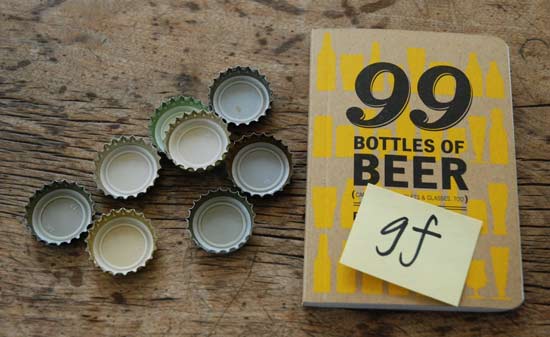
12th November 2016
It’s been a mad week. Stung by wasps. A freezing swim in the sea. Driving 86 miles for a bowl of GF chips. And to top it all, a monster has just been elected leader of the western world.
An innocent trip up the garden with a friend on Wednesday ended with us being chased back down again by an angry swarm of wasps. Stung twice through a hole in my trousers, I managed to rip off my clothes outside the front door, to the amusement of my friend, only to receive another sting later as soon as I put my socks back on.
Clearly feeling guilty she’d somehow managed to avoid the wasp stings Sarah surprisingly agreed to a trip in the campervan a few days later, bribed with the promise of a walk, supper in a great pub and breakfast of boiled eggs. Unfortunately I omitted to mention the no-bread-in-the-van rule.
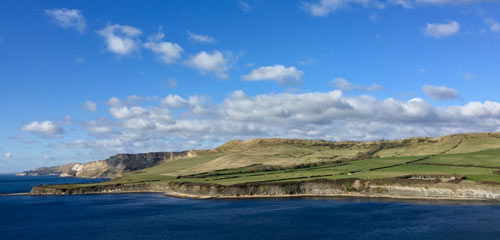
It was freezing with a cutting northerly wind when we set off, and probably not the best day for wild camping, but armed with Everest sleeping bags, extra duvets and enough beer, wine and sloe gin to sink a ship, we drove to the coast to set up and have an afternoon walk. I had a nagging worry about the bread Sarah claimed she’d brought but it was too late to say anything
The promised sun emerged on cue, although it wasn’t the ideal time of year for a dip, especially for someone who can hardly be persuaded to swim in the UK on a blistering day at the height of summer. But here, at Dancing Ledge, on November the 5th, something weird happened and I was inspired by a stranger who showed me the way down the rocks to strip off without either towel or swimsuit and swim in the freezing pool. Only when I made my way back dripping to my amazed friend did I realise the shortcomings of bravado.

Back in the van, the drop in temperature and impending darkness put a whole new complexion on things. Filled to the roof with boots, duvets and sleeping bags, any internal manoeuvring proved so difficult we soon gave up completely on the idea of reading and headed straight to the pub.
Suffice to say our supper was not the highlight that was anticipated. Faced with an empty dining room or an almost-empty bar with 4 blokes standing round in desultory fashion in their coats watching football on the biggest screen I’ve ever seen, we sat on a cold leather sofa and chose our food.
‘I don’t think I’ve ever been anywhere so absolutely lacking in ambiance,’ Sarah said, heartfeltly. She necked some whisky.
We made the most of the chips and drove back to our camping spot, only to find it had been stolen by another van. Despite the roaring gas-heater, it was cold inside and the bright lights gave off a very unattractive green-tinged light. It seemed too miserable to even have a drink. So at 8.30pm I put up the roof and climbed into the top, whilst Sarah spread out on the pink candlewick-bedspread downstairs.
Although we were both warm in our Everest sleeping bags it was a long and sleepless night. ‘Do you realise that whenever you turn over it rocks the whole van?’ Sarah asked. I lay up top without moving and listened the sound of her unsleeping breathing below. Only with the arrival of dawn did we finally get some sleep.
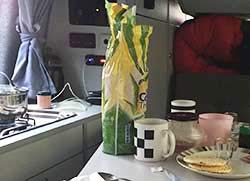 The next morning was cold and damp and there was no tea for some time until we’d retrieved the kettle from the inaccessible cupboard under the bed. The next morning was cold and damp and there was no tea for some time until we’d retrieved the kettle from the inaccessible cupboard under the bed.
All in all it was a bit of a pathetic breakfast, although I did manage to provide 4 cracked, almost-cooked, boiled-eggs. The gluten crisis was averted by Sarah’s forethought in packing her bread buttered, in sandwich form, in a plastic bag. She didn’t drop a crumb. Grateful I’d kept my mouth shut on the subject, I was chuffed to have such a good friend. In retrospect, 86 miles is too far to drive for any sort of chip, GF or not. One day I will make it up to her.
30th September 2016
Being barred from the table: the emotional fallout
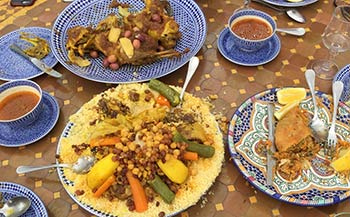 It’s common for coeliacs to feel bad when invited out to eat – our interpersonal relationships are affected when we can’t participate in that important social act of sharing food. It’s common for coeliacs to feel bad when invited out to eat – our interpersonal relationships are affected when we can’t participate in that important social act of sharing food.
If a little bit of you is filled with dread when someone asks you out for supper, you’re not alone. Coeliacs often feel curmudgeonly and mean when there’s an invitation involving food. Don’t beat yourself up about it; there’s a reason for your nagging negativity and it’s not because you’re selfish.
When we share food we celebrate both friendship and community. In her column, The Kitchen Thinker, the writer Bee Wilson goes further and says that ‘Food is love and home and culture…’ We forge the bonds of belonging through eating with others. Coeliacs and those with allergies and intolerances are often outsiders at the table, unable to participate in these shared experiences which foster friendship and wellbeing.
Although we coeliacs hide our feeling about eating out because it makes us feel ungrateful and selfish, it helps to know we’re not alone. There are good reasons we feel like this.
In a fascinating study called Food for love, Myrte Hamburg et al examine the psychological effects of food offering and sharing. It shows how eating together and sharing food both regulates emotion and increases closeness. It’s a way of showing support and care; it brings people together and encourages interaction.
Learning to manage the feeling of dispossession when you’re diagnosed with coeliac disease is as difficult to deal with as the diet. It’s larger than simply not being able to eat all the foods you previously consumed. It strikes at the very heart of your identity and makes you feel an outsider in a world where previously you had a place.
Coeliac disease brings exclusion from anything that involves food. And now virtually everything does. Eating is a social activity, it’s sharing, it’s pleasure. To decline food snubs those who offer us hospitality and celebration.
Food for love claims the emotional, soothing effect of comfort food is actually deeply embodied in our memory. Coeliacs diagnosed as adults are forced to abandon this intuitive and fundamental response because their food is suddenly deemed out of bounds. Citing this 2005 study, the authors assert that eating ‘nostalgic food’ strengthens our feelings of identity, and makes us feel part of a group, reinforcing our ‘cultural and familial bonds’.
Food for love also mentions the ‘universal quality’ of offering food. As most other types of intimate interaction are only carried out within the confines of an already-established close relationship, it suggests that offering and sharing food with strangers is a way to make contact, strengthen bonds and even appease enemies. When we eat together we actually grow closer through the act of sharing.
So although it’s hardly surprising we often feel miserable in food-sharing situations, just don’t let it get to you, as I once did at an excruciating work meal. I went out with some new colleagues on the first day of a job, somewhere I knew I couldn’t safely eat. I then refused all food (and wine), was miserable and resentful all evening and went home early on my own.
It was a textbook case of how to make yourself really unhappy. By dint of not eating, I excluded myself totally from all the fun and then felt rejected and isolated. If I’d managed it better I’d have drunk some wine, gone over to the newsagents, brought back bags of nibbles to eat and had a great time making friends, just like everyone else did.
Food and sharing plays such a pivotal role in social relationships that for our own happiness it’s important to work hard to keep that seat at the table.
25th August 2016
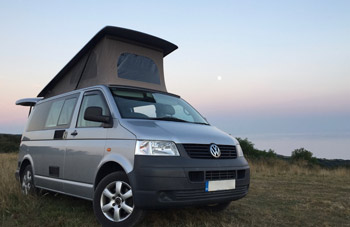 I have driven 215 miles home and am sitting at the kitchen table surrounded by a large cardboard box, a 5-lever mortice lock, a carton of Persil, and 16 bay leaves. The table is a mess but the bay leaves are arranged like an exhibit in an art gallery. The sound of sport is coming loudly from the living room. I have driven 215 miles home and am sitting at the kitchen table surrounded by a large cardboard box, a 5-lever mortice lock, a carton of Persil, and 16 bay leaves. The table is a mess but the bay leaves are arranged like an exhibit in an art gallery. The sound of sport is coming loudly from the living room.
Looking round the kitchen I size up the food situation. 2 avocados - almost, but not quite ready - sure to be a disappointment, half a bottle of warm white-wine and 2 pieces of old cheese (which I immediately eat) before deciding to have supper of out-of-date Genius toast with pasta sauce.
My only interaction with J is when he briefly emerges from the other end of the house to say ‘Don’t eat the pasta in the saucepan,’ and disappears back into the noise. It’s nice to have someone who looks out for you.
I knew the pasta was full of gluten before I even opened the lid. A few days away and J goes on a gluten binge, back to a normal life full of beer, pies and penne. He’s usually sick of it and desperate for salad by the time I get back.
The next day I discover the secret hiding-place in full view where J puts foodstuffs he wants to keep for himself. For several hours a brown paper bag sat on the gluten side of the worktop. I assumed it contained a cake or a scone, something to be savoured later with a cup of tea. I successfully ignored it for most of the time, then peered through the top of the bag. Inside were broad beans - my favourite - successfully disguised as a toxic substance.
People with allergies or intolerances are experts at negotiating toxins, after all, we spend our lives doing just that. This week I had to meet someone for lunch in a Birds’ coffee shop. I walked in holding my breath and viewed the display full of flaky pastry, saw the breadcrumbs, the shared utensils, and the dish of wrinkly jacket-potatoes in the hot cabinet where the sausage rolls and cheese pasties deposited their pastry flakes over the glass shelves. I looked up at my friend, and saw she was set to stay. Resolving to just have coffee, I was delighted when she turned and walked away. Not because of the gluten issue, but because they didn’t serve the brand of drink she wanted.
Each mealtime in unfamiliar places we make judgements about safety and risk. Most of us have to do it in our own home if it’s shared with others who eat the foods we can’t. Good routines lessen risk but even they can’t prevent mistakes from happening, especially when alcohol’s involved.
Now at home we have a new space in which to renegotiate the matter of gluten. I have bought a camper van. Discussions are on-going as to whether or not it will be a GF zone. J is keeping quiet on the subject because he wants to borrow the van to go away. I know he has secretly decided to ignore me and just clean out the breadcrumbs and bits of pasty before he returns.
I don’t mind too much because the van doesn’t actually feel like mine yet. When he gets back and it’s cleaned out, it’s going to be strictly GF. There’ll probably be a Tupperware box with bread in but he’ll be banned from opening it inside the van. I can’t negotiate gluten in a space so small.
2nd July 2016
I spend the small hours when sleep will not come worrying about bread…
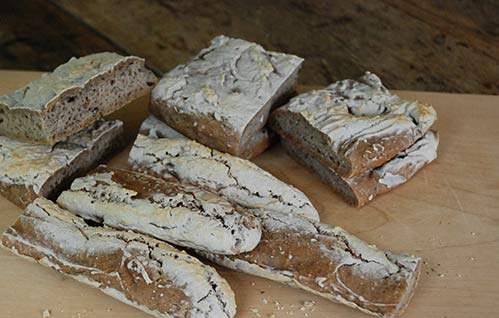
Bread is probably my favourite food. I say probably but in truth there’s no contest, even though it’s GF bread. I’m a little ashamed - I know it should be avocado, or buffalo mozzarella from Lazio, but there we have it. My favourite food is one which, in its perfect incarnation, is inedible to coeliacs.
With this vast weight on my shoulders I spend far too much time thinking about bread. I even worry about it. In the depths of an unforgiving night, I panic that the one I rely on every day will be discontinued.
Last year I worked with a woman who viewed the world through lists. ‘Your three favourite foods?’ she’d always ask, or ‘The three things you miss most?’ So, for Pru, here is a list of my favourite bread…
In top place, Adriana Rabinovich's sourdough, closely followed by Naomi Devlin’s sourdough. In third place, and the one I eat every day, Barkat Wholemeal Sliced Bread – the source of nocturnal angst.
I believe Adriana’s sourdough is the best GF bread in the world. (I know this because I have tried all the others.) The only trouble with it, and the next one on the list, is that I have to make it. The starter takes a while to get going and I already have enough bacterial communities to look after, what with kefir and kimchi. Sometimes a third seems too much of a faff. The only other thing about this bread, and I admit it’s entirely my problem, is that last time I made it I ate so much I was ill.
Naomi’s delicious Chestnut and Buckwheat Cheaty Sourdough is light-textured and quick to make. If you have a supply of chestnut flour this is the perfect place to use it.
But Barkat is the bread I eat most frequently and the cause of night-time anxiety. Sometimes in those long hours when sleep won’t come, and my mind can’t cope with problems of earth-shattering magnitude, the future of this bread is what I worry about.
I know I’m not alone in concern that a product on which I rely might be discontinued. Allergy Mum UK tweets about her anxiety that the only products her multiple-allergic son can eat might be withdrawn. Sometimes items just vanish from the shelves and never appear again.
So why do I think my daily bread might disappear? The perceived change in GF as a fashion choice rather than a medical one; the demise of prescriptions; the weird look of the bread and, most of all, its terrible marketing, means that I think the Barkat could well be heading for the chop.
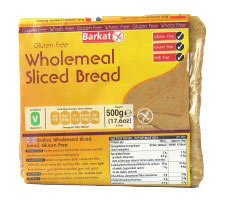 True, it resembles a cartoon of pre-war GF bread. True, it looks like it comes out of a tin, although on the plus side it would make the perfect weapon to knock out someone who thinks gluten’s a joke. True, it resembles a cartoon of pre-war GF bread. True, it looks like it comes out of a tin, although on the plus side it would make the perfect weapon to knock out someone who thinks gluten’s a joke.
But if you want to know why I eat something that most people view in horror, it’s because of two things – ingredients and taste. In a world where food fads rule (and although I hate the word) this bread is clean. It’s got few ingredients and they’re all proper food substances. It tastes good when lightly toasted. Barkat’s Wholemeal Sliced Bread is the coeliac’s pumpernickel. It’s dense, chewy, and has the slight acidity of good bread. It has an OK nutritional profile, isn’t too high in fat, contains no sugar, is long-life, and best of all – I don’t have to make it.
All the Barkat needs is a new strap-line and a nice pack. This would give it a fighting chance of survival. And then I’d sleep better at night knowing I could worry about other things.
14th May 2016
 Filming in deepest Africa Filming in deepest Africa
Our meals usually go like this. After a few hours in the inferno of heat, red dust and humidity, we drive to the haven of an air-conditioned restaurant and collapse in the cool. We peel off any clothes that aren’t sticking to us too much to remove. Then we ask for the wi-fi password, water and bread, in that order, throw ourselves across as many seats as we can find and bury our noses in our mobiles while we wait for food to arrive. Seven faces lit up by the ghostly glare of screens would greet the eyes of anyone watching.
Sometimes the food arrives, sometimes not. Often it appears just as we have to leave and has to be gobbled down in seconds. Climbing a series of rough steps in the forest carrying bags of equipment in temperatures of 36 degrees only a minute after you’ve wolfed down a cheese and pineapple pizza is not an easy feat. My lunch of rice and tomato ketchup may have felt insubstantial at the time but at least it spared me from the worst of the post-meal torpor that settled over us like a blanket as we dragged our limbs up the winding track that for some inexplicable reason felt like the slope from hell. Very occasionally starving coeliacs are slightly better off.
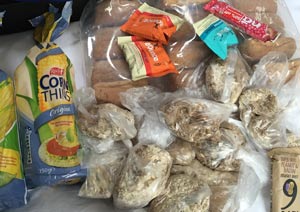 At breakfast I am super-sorted. 21 bags of muesli came out with me at the start of the trip and there are always trays of delicious fruit to have with it. On day 5 someone eyed up my cereal and asked where I’d got it. By comparison the gluten-eaters’ breakfasts are unreliable affairs of unspeakable fou-fou porridge and the vague possibility of omelettes, which never quite seem to materialise in time. But I am happy as Larry. At breakfast I am super-sorted. 21 bags of muesli came out with me at the start of the trip and there are always trays of delicious fruit to have with it. On day 5 someone eyed up my cereal and asked where I’d got it. By comparison the gluten-eaters’ breakfasts are unreliable affairs of unspeakable fou-fou porridge and the vague possibility of omelettes, which never quite seem to materialise in time. But I am happy as Larry.
The rest of the time there is rice. Sometimes rice and delicious fish, other times just rice, if circumstances are too complicated to navigate. This is fine, if a little boring, but to be honest, most of the time you just shovel in enough fuel to get you through the next part of the day, grateful to be in the cool for a few moments.
After two weeks of fou-fou, Jollof rice and unreliable omelettes, everyone was much looking forward to the hotel in Cotonou and the mountain of baguettes, croissants and pain au raison that greeted us at breakfast every day. It was back to normal on the food front. I studiously ignored the gluten that seemed to be everywhere again and concentrated on eating as many creamy yoghourts as I could manage.
On our last day there we rose at 02.30 for an early flight. A spread of baked goods and coffee was promised downstairs at 03.00. ‘Veuillez me laisser un petit plat de fromage et tomates?’ I asked, knowing there would be nothing for me to eat otherwise.
I came down early to make a sandwich for the journey. The others’ food hadn’t yet been laid out but, just as requested, alone in the middle of the empty table lay a large plate of cheese and tomato.
I dived in and ate the lot, barring a couple of slices. My colleagues stumbled in, faces crumpled from lack of sleep.
‘Who’s eaten all this cheese?’ said one accusingly, looking at me. ‘Was that you?’ he demanded.
‘Dead right it was,’ I said, and smirked with private pleasure.
30th March 2016
River Cottage Goes Gluten-Free (for an evening with Naomi Devlin)
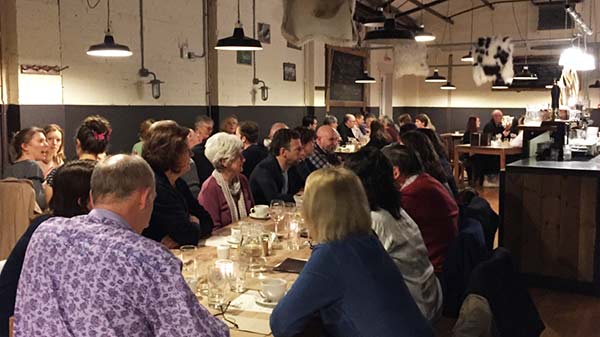
Being a miserable so-and-so I don’t often eat out. It’s more fun at home and the food’s better. If I do go out there’s always a gluten-related incident and that can spoil the evening if you’re not feeling strong and brave. An ideal meal is one in which coeliac disease plays no part and we can all eat what we want in peace without having to mention the G word.
A nice thing happened this week though, and not only did I go out to eat - on my own - but I had a really good time. I learned lots about nutrition, had a delicious three-course set-meal with focaccia and blinis (in which gluten didn’t get a mention) and spent a riotous evening laughing and chatting with two extremely good-fun women who happened to be sitting next to me.
The idea behind the event isn’t new – it’s themed communal-eating with an add-on. A restaurant opens for the evening and an author talks about her new book. Throw in the chance to meet her and ask a few food-related questions, then enjoy a three-course meal with like-minded people – something Kim Smith’s been doing with great success in London at her company Gluten-Free Gathering.
The food I enjoyed at River Cottage’s evening with Naomi Devlin, author of the new River Cottage Gluten Free cook book, made me think how nice it would be to be part of a regular, gluten-free supper-club – somewhere you could go every month or two, eat a safe, gluten-free meal, and share the table with strangers who you may never see again but are friendly, companionable and on the same planet when it comes to gluten.
I turned up to Naomi’s event at River Cottage Canteen on my own but most people already chatting away at the five large tables were in groups of twos, threes, fours and fives. Axminster’s a rural area and they’d come from as far away as Bath and Exeter. Most were families and friends accompanying a coeliac - showing that if you offer GF food you feed extended groups of people, not just the intolerant diner. Indeed I had an unexpectedly enjoyable evening, chatting to two punters with no food issues at all who’d just turned up for the nice meal, happy to listen to Naomi and enjoy the good food. The place settings were the luck of the draw but it was so laid-back an event that it was impossible not to be drawn into other people’s conversation and make friends with adjacent diners – which is what communal eating is all about.
Naomi’s easy presence made for an enjoyable evening, and as she moved from table to table chatting and answering questions I could hear her offering tips on all manner of subjects from flour to fermentation and baking.
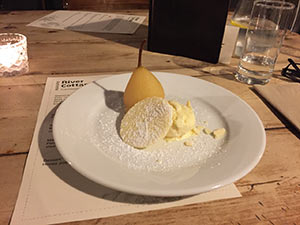 This is my ideal supper-club – a communal meal at long tables with a random assortment of people, all enjoying a meal in a companionable, friendly way. Throw in the good-quality food, the fact that it’s prepared in a safe environment by chefs who know what they’re doing (and that every item on the menu is GF) and you move into seriously-good-evening-out territory, something that doesn’t happen too often. So well done to River Cottage, and thanks to Naomi as well. It’s an idea worth repeating. This is my ideal supper-club – a communal meal at long tables with a random assortment of people, all enjoying a meal in a companionable, friendly way. Throw in the good-quality food, the fact that it’s prepared in a safe environment by chefs who know what they’re doing (and that every item on the menu is GF) and you move into seriously-good-evening-out territory, something that doesn’t happen too often. So well done to River Cottage, and thanks to Naomi as well. It’s an idea worth repeating.
Eating together and sharing food is one of the most sociable ways to pass the evening and something coeliacs can’t often do in restaurants. River Cottage Canteen Plymouth is now planning to open for another exclusively-GF night in April - minus Naomi, of course - and I hope Axminster might also follow suit, if there’s enough demand.
One day, inspiration rekindled after this enjoyable night out, I’d like to host a pop-up GF supper-club at home. Nothing flashy; just good GF food, made in a safe kitchen and eaten at a communal table by a handful of people who want to go out and enjoy supper without having to mention the word gluten.
4th March 2016
All I (don’t) Need Is The Air That I Breathe
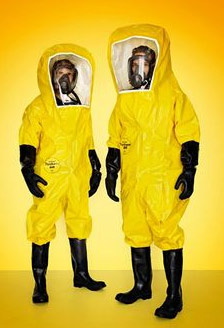
If you think the good thing about coeliac disease is the fact you have to actually eat something for it to make you ill, you might want to reconsider. Sometimes you just need to be in the same room. Two encounters with airborne gluten have left me wondering whether breathing in flour dust can be dangerous for coeliacs. Surely it can’t be true that particles we breathe in end up in our stomach?
After diagnosis I stubbornly persisted in making bread for the people I loved. It had been such a part of my life that I just couldn’t stop doing it. But gradually I became aware of how, despite my best efforts, the flour went everywhere, and that even though I tried to hold my breath when I was weighing it out, I could still taste it afterwards. It was the kiss of death for my bread making and these days I give flour a wide berth.
On a farm in Cambridge, I had to go deep into a field of what I thought was wheat as it was being harvested. The wind was blowing towards us and great clouds of dust billowed from the combine in our direction. I was petrified, thinking ‘I can’t, I can’t do it,’ until, at the very last moment, I saw the crop was oats, not wheat, and in I went, relieved not to have been a wuzz.
Unquestionably, the inhalation of large quantities of airborne dust - whether in a bakery or on a farm - is dangerous for everyone, but I’ve begun to wonder if the possible ingestion of gluten this way is problematic for coeliacs. Contrary to what I imagined, could it really be the case that all that gluten dust ends up exactly where we don’t want it?
Noses are our first line of defence against dust. They filter the air we breathe and prevent dangerous particles from entering the lungs by trapping them in the tiny hairs (cilla) that line the nasal cavity. The movement of the cilla - and the mucus that constantly lubricates and cleans the nasal membranes - collects and moves foreign particles towards the throat, where they’re swallowed and end up in the digestive system. (Yes, I know...)
We’re barely aware of the process that protects our lungs from airborne pathogens, but it means that if we do breathe in flour dust - and don’t sneeze, or blow our noses - it ends up in our stomach.
There is little research on the risk of airborne-gluten ingestion for coeliacs, but in this 2007 study, 2 farmers with non-responsive coeliac disease who were inhaling and ingesting large quantities of gluten-containing dust, both saw symptomatic and histologic improvement after wearing face masks.
So it does indeed look as if being in a gluten-rich environment with a lot of airborne particles might be particularly dangerous for coeliacs. Of course it also depends on how much dust, and what type, is in the air. But bakeries, breweries, fields at harvest time, places handling animal feed and indeed domestic kitchens - where a lot of flour is being used – could all be risky environments which are best avoided.
I don’t usually need a good reason to hold my breath when I walk past the bread counter but now there actually might be one…
6th February 2016
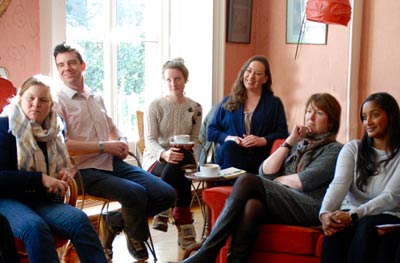 Each day for a couple of weeks at this time of year a small procession of people turn up at a house in North London. They look happy and excited. Often they have a story to tell about food and their journey in the less-known world of allergy and intolerance that has lead them to take time off from work or family to do what they are about to do. Each day for a couple of weeks at this time of year a small procession of people turn up at a house in North London. They look happy and excited. Often they have a story to tell about food and their journey in the less-known world of allergy and intolerance that has lead them to take time off from work or family to do what they are about to do.
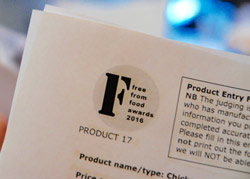 These people sit at tables in silence and judge food. Bread, cereals, cakes, bars, super-foods, store-cupboard items, ready meals. You name it, they taste it. You know all those items in the supermarket with the yellow ‘F’ on them? They’ve eaten them, discussed them, scrutinised the ingredients, tasted them again, argued about them and awarded them a mark. Nobody knows what they’re eating. Every product is tasted blind. Welcome to the Free-From Food Awards. These people sit at tables in silence and judge food. Bread, cereals, cakes, bars, super-foods, store-cupboard items, ready meals. You name it, they taste it. You know all those items in the supermarket with the yellow ‘F’ on them? They’ve eaten them, discussed them, scrutinised the ingredients, tasted them again, argued about them and awarded them a mark. Nobody knows what they’re eating. Every product is tasted blind. Welcome to the Free-From Food Awards.
Judges talk about their lives with coeliac disease, tell tales of multiple-anaphylactic children who can tolerate only 5 foods; of being scared to kiss their allergic daughter after eating pesto because it contains milk; of not being able to eat any savoury food at all when they go out because of an allergy to chilli. Gluten is frequently not the only thing they can’t eat.
These are the stories that lie behind the awards, and behind many of the small producers who make Free-From food; stories we should all hear occasionally because they make just having coeliac disease not quite so bad after all.
For product developers and manufacturers these tasting sessions are a great way to meet consumers, get an overview of the market and see what’s lacking. I love trying a myriad of new products, items I never knew existed and would never find on my own. Any self-respecting coeliac can’t fail to be excited when they walk into a room and see a table laden with gluten-free breads of every colour, shape and size, knowing that they can eat every single one of them.
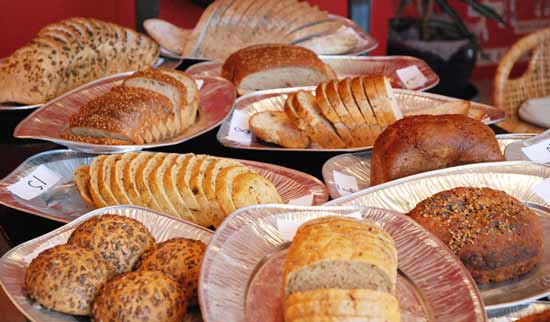
My personal top gluten-free picks? Origin Earth GF Crispy Bread Crackers with Caraway, which would happily grace the finest tables in the land; delicious, light, crisp, savoury biscuits made from sprouted soya beans with a deck of ingredients so clean you really want to cheer; Tesco's incredibly well-priced, frozen, Free From Garlic Bread (also onion rings and scampi), soon to be available in freezers near you; Nutribix Gluten Free, a clever, Weetabix-like cereal, made from sorghum laminated into the thinnest, crispy sheets; Rana's Nearly Rye Mix, an easy-peasy ‘rye’ packet bread-mix which couldn’t be any simpler to make; Cofresh Sea Salt Flavour Lentil Chips, light, clean-tasting crisps, perfect for dipping or drinking with beer (of which there was a large category of its own with a very interesting winner!)
It’s nice to know there’s a whole community of coeliacs judging these awards.
Nobody but us knows how hard it is to find a gluten-free doughnut or a food-service banana bread that would sit easily on the main counter at Café Nero without anyone knowing it’s gluten free. Restaurants and cafes please note: here are products that really are good enough for everybody to want to eat and drink.
For more on the FreeFrom Food Awards check the site here.
5th January 2016
What do dhal baht and Vivaldi have in common?

Driving home yesterday after a bad week I was commiserating with myself about how awful it is to have coeliac disease. I was writing a new definition in my head. I decided the usual ‘Coeliac disease is an auto-immune disease where the ingestion of the proteins found in wheat, barley, rye (and sometimes oats) causes an inflammatory response that can lead to serious illness’, should be replaced by ‘When you have coeliac disease just about all processed foods make you ill’, followed with ‘If you live outside a major city you will find it almost impossible to find food when you’re out.’ Or to make it short, ‘When you have CD life can be truly crap.’
Things had not been good and I was feeling sorry for myself on the food front. I know CD isn’t a bad disease to have. It’s nowhere near as serious as life-threatening allergies and you never seem to hear people with those moaning about their miserable lives. But it does get you down and sometimes it would be nice to complain about your food-related existence to someone who doesn’t think you’re a boring, self-obsessed whinger who goes on and on about eating all the time.
So there I was in that place of abject self-pity in which one occasionally ends up when a great piece of music came on the radio. Some Vivaldi so gloriously happy that it transformed me from a miserable, resentful coeliac into a reasonable human being again.
The thing about CD is that it never goes away and leaves you alone. When you’re full on and busiest and haven’t had time to think about supplies, wham, it hits you in the face and you realise you’re not going to find food. I’m not talking about eating in restaurants, I mean ordinary, bog-standard everyday food from small shops, other people’s houses, and service stations.
Sometimes it seems as if the whole world is made of gluten and trying to avoid it is like carrying the weight of an invisible suitcase on your back. When I’m really fed-up I’d like to show it to other people and let them see how it feels.
So that’s the moan, and I’m already feeling better for having said it. I know CD’s not that bad and I’m not going to die of it but that doesn’t stop it being A RIGHT OLD MISERABLE HASSLE EVERY SINGLE DAY.
Now, back to dhal bhat and Vivaldi. They sorted me out. A surprise plate of dhal bhat, the lentil stew you have twice a day in the Himalayas (and become so sick of on an expedition you think you’ll never eat again as long as you live) made a quite brilliant breakfast, transforming a bleak morning with no other food into a good day. Then driving home, ruminating on the misery of life with CD, Vivaldi came on the radio and made a vituperative coeliac into a happy human being. Music and food really can make everything OK.
5th December 2015
Indigo..... Heaven on a plate for a coeliac, a dairy intolerant and a vegetarian!

Sometimes the journey home is the best bit of a night out. Cycling across Bristol in the early hours, white hair blowing in the wind, I once passed a drunk who shouted triumphantly ‘It’s fuckin’ Einstein’ as I flew past. Another time, on a summer’s evening in Bath, walking up Milsom Street long after the pubs had shut, we were serenaded by tramps in adjacent shop doorways singing Bridge Over Troubled Water, the chorus a distant, fleeting echo from up the street.
So it is of concern, on nights of which I have high hopes, that the journey might actually be the best part - and I feared the trip to Indigo could be one such occasion. Storms were forecast and I was already looking forward to the windswept walk along Embankment and over Waterloo Bridge to the hotel restaurant with the headline-grabbing food.
Indigo, at No 1 Aldwych, has been home over the years to a succession of well-known chefs. Dominic Teague took over in 2012 and caused much excitement on social media last month when he announced that his evening menu has been totally gluten and dairy-free since June.
Our trio of diners - a coeliac, a dairy intolerant and a vegetarian - is the stuff of nightmares for most restaurants, but Indigo has been rising to this particular dietary challenge for months without people realising. I assumed they would provide us with safe food and I was hoping the meal would be the high point of the evening.
Indigo’s mezzanine restaurant is set high above the hotel lobby and bar. It’s plush, in a comfortable and grown-up way, and the staff friendly. Our queries (and there were an awful lot) were answered accurately and with goodwill. It’s almost impossible to completely relax in a restaurant if you have CD, but at Indigo you come close to it.
The set menu, £25, for three courses - each offering three GF and DF dishes, is terrific value. I ate salmon and beetroot with rock samphire; gilt-head bream with sea-beet and celery. The others, Highland partridge (with a tiny spoon of cauliflower so fine and creamy we wished there were cups of it); pork cutlet with damson compote; charred sweet corn, steamed buckwheat and girolles.
Simple touches made the meal: the ramekin of grassy rapeseed-oil and tiny, salty loaves of buckwheat, rosemary and samphire bread meant that, possibly for the first time since diagnosis, I was able to sit in a restaurant and share bread with friends. It just felt great.
Of course Indigo doesn’t provide food for coeliacs and dairy intolerants out of kindness - it’s a top-end restaurant responding to food trends, but it meets the challenge with meticulous attention to detail. The menu is genuinely inspired and they take cross-contamination - exhaustively quizzed about on the night, and confirmed in two subsequent emails - very seriously.
Puddings provided unexpected explosions of flavour and were shared and polished off rapidly. It would have been easy to stay longer in the soft quiet of the restaurant, watching the windswept passers-by on Aldwych, the drinkers milling in the lobby bar below.
After adjourning to a nearby pub, we sat unabashedly discussing digestive issues next to a solitary diner who was downing pints with a large plate of roast dinner. He kept his head glued to his paper. Hearing a squeal, I turned round just in time to see a gust of wind deposit a large cardboard box over the head of a woman standing outside on the pavement. The journey home was not looking so pleasant after all.
Two beers and a whiskey later, having run the gamut of food intolerances, we raced to the top of the bus and sprawled across the front seats enjoying the view of the city in the gale. Thus ended the evening and, thankfully, the meal was the best part.
If you have coeliac disease or are dairy intolerant, do try Indigo. Take your friends and revel in its rare pleasure. Don’t leave it too long though, food trends never last forever…
For another rave reivew from Simon Wright see here.
7th November 2015
Caterers are learning... slowly....
I have been away for over a month and have come home with a hacking cough and 3 kilos of quinces.
At work, perfectly normal-looking men have been eating plates of avocado, spinach and gluten-free bread for breakfast. Nobody bats an eyelid, apart from the alpha males tucking into fry-ups. They cast sidelong glances at their neighbours’ green breakfasts and then look down at their own comforting plates of Full English.
No wonder they think the world has gone bonkers. Crazy diets have always been around but now even quite ordinary blokes eat mountains of raw spinach for breakfast.
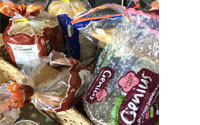
There’s always gluten-free bread on the table at work these days. But it’s been ripped wide-open and put in the gluten bread basket with all the other loaves of bread, under the steady traffic of hands and crumbs. It’s usually smashed to smithereens too. If I do chance it, I insert my hand gingerly and take a slice from the very bottom. The other GF-bread eaters put theirs straight in the communal toaster. I smirk and tut on the side lines with no effect. It’s too early for irony.
Over the last month I’ve eaten well, and safely, at work, looked after by a bunch of great caterers who somehow cope with the demands of vegans, vegetarians, coeliacs, all manner of allergics/intolerants and the bunch of annoying ‘clean eaters’ (who, after rampaging through all the GF food, annoyingly partake of pastries and cake) with imagination and diplomacy. They’re great cooks and, even though they often mix up having to avoid gluten with being vegetarian, they make delicious meals every day under the most difficult circumstances.
Some would say that asking people who feed you in restaurants if they can define gluten is a nasty trick. The answer’s complicated to the uninitiated and it puts them on the spot, whilst most ordinary people don’t have a clue. But I think we should expect caterers, chefs and people involved in food preparation to know the answer, and a large number of them don’t.
Some have a partial idea, like this group I asked last week.
‘It’s wheat. Wheat-free. Wheat. Wheat. Wheat.’
‘Anything else?’
‘Well it’s just wheat-free, innit?’
‘Well, what’s gluten in then?’
‘Well it’s in loads of stuff. You’d be surprised. Gravy, even vegetarian gravy. Just about anything. Loads of stuff. Stock. Anything with pastry. Err, even things that you don’t even….like you say, soy, that’s got wheat in it. Things that you wouldn’t even think had got wheat in it. I tell you a good substitute is coconut flour and coconut oil…..’ (Cue digression away from difficult subject of gluten onto spurious waffle about coconut.)
Of course none of us would knowingly eat at a place where this is the limit of the chef’s knowledge, but the fact is we assume that people involved in catering have had some degree of training - yet this is not always the case. I’ve heard some really amusing definitions of gluten, usually involving potatoes and cheese.
Emboldened by my questioning, which wasn’t nearly as hard to do as I thought, I’m going to be asking more professionals involved in feeding me to tell me what they think gluten is. And if they can’t answer, I’m going to help them out. After all, if the chef doesn’t actually know, how exactly can they make safe food?
10th October 2015
Veggie sausage tasting!
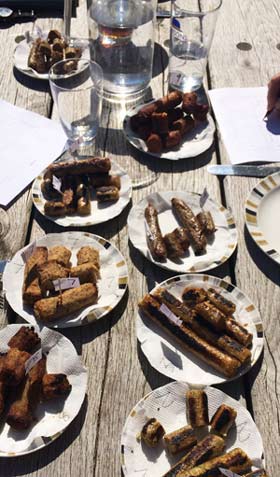
Lunchtime on a late summer’s day. A table of hungry friends. The smell of gluten-free veggie-sausages being cooked to perfection wafting from the kitchen.
This was a tasting I’d always hoped to attend – as participant, not chef. Although I’d long been on a mission to find the best gluten-free veggie-sausage, what I didn’t envisage was holding a tasting which involved a skill that has somehow eluded me - cooking things according to their instructions.
In the end I realised nobody else was going to do it for me so I might as well just get on with it. Summer was already tinged with the feel of autumn by the time all the sausages arrived and the veggie guests were free at the same time.
So there we all were, eager from the anticipation, me a little less so because my excitement was being rapidly tempered by the demands of grilling and frying all those sausages so they emerged at the same time, perfectly cooked, unstuck and in one piece - a scenario never achieved before in all my years of veggie-sausage cooking.
There was also the small matter of the labelling and cooking of items that roll around and look identical but which have to be kept separate. It was fiddly and stressful and the guests, tasting blind and banned from the kitchen, were all outside hungry and waiting.
Whilst I was inside swearing at the malfunctioning grill and juggling frying pans, sausage cartons and labels, they became bored in the garden and started complaining and making a lot of noise. They demanded alcohol, which I had rashly decided would be a bad thing. Obviously this didn’t go down well and they were starting to get rowdy and rude when the sausages finally came and they fell on them like a plague of locusts and then were quiet at last.
The verdict? The sausages all behaved impeccably (the guests not quite so well).
We tasted a selection of veggie gluten-free sausages by Dee’s , Dragonfly Foods, Secret Sausages, and Wicken Fen.
Dee’s
We loved the look of the strings of Dee’s sausages, ‘Looks appetising, like a real sausage,’ one taster wrote. ‘A firm and chewy texture’. The unusual ingredients give the sausages a ‘savoury, salty flavour.’ Their three flavours, Roast Garlic and Mushroom, Leek and Onion and Traditional Vegetarian worked very well with spicy pasta in the leftover dish I made a day later.
Dragonfly Foods
Everyone liked Dragonfly Foods’ skinless sausages and they scored commensurately. ‘Satisfying and sausagey, ‘mmmm, sagey flavour’, ‘tasty’, were just some of the positive comments. Their Organic Soysages came out fractionally ahead of the ‘Leek and Potato, which came ‘a close second’, someone noted.
Secret Sausages
We liked the look and texture of Secret Sausages, ‘nice texture in the mouth,’ someone noted, but we found all 3 varieties slightly sweet. Their Lincolnshire scored higher than Garlic and Rosemary and Chilli Dogs, and they have an impressive range of 9 from which to choose.
Wicken Fen
Wicken Fen’s large Carrot and Coriander sausages scored highly. Sold loose in a handy self-seal bag, everyone liked their robust flavour and substantial texture. ‘Good flavour, tomatoey/slightly spicy,’ and ‘top snag; winner,’ were just some of the enthusiastic comments.
Dragonfly Organic Soysages and Wicken Fen Carrot and Coriander won the taste test, but we happily polished off almost all of the sausages with enthusiasm. Although I couldn’t face another one for 24 hours, all the leftovers, which we ate with a spicy GF penne a day later, tasted exceptionally good. Congratulations to Dee’s, Dragonfly, Secret Sausages and Wicken Fen for coming up with an alternative to gluten in products which normally rely on it.
Ingredients
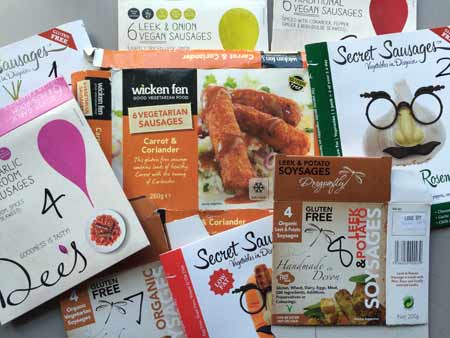
Dee's
Leek and Onion Vegan Sausages
Ingredients: Pea Protein from Yellow Peas grown sustainably using environmentally friendly methods* in the North of France, Irish Rapeseed Oil, Navy Beans, Black Beans, Irish Dulse Seaweed, Leek & Onion, Herbs and Spices, Ground Flaxseed.
Roast Garlic and Mushroom Vegan Sausages
Ingredients: Pea Protein from Yellow Peas grown sustainably using environmentally friendly methods* in the North of France, Irish Rapeseed Oil, Navy Beans, Black Beans, Irish Dulse Seaweed, roast garlic, porcini mushroom Herbs and Spices, Ground Flaxseed.
Traditional Vegan Sausages
Ingredients: Pea Protein from Yellow Peas grown sustainably using environmentally friendly methods* in the North of France, Irish Rapeseed Oil, Navy Beans, Black Beans, Irish Dulse Seaweed, Herbs and Spices, Ground Flaxseed.
Dragonfly Foods
Leek and Potato Soysages
Ingredients: Dried Potato Flakes (40.3%), Cooked Brown Rice (32.3%), Soya Bean Fibre (10.75%), Garlic, Onion, Cooked in Sunflower Oil with Almond, Walnut and Sesame Trace.
Organic Soysages
Soya Bean Fibre and Curd (64%), Cooked Brown Rice (34%), Tamari, Black Pepper, Sea Salt, Cooked in Sunflower Oil with Almond, Walnut and Sesame Trace.
Secret Sausages
Chilli Dogs
Ingredients: White Rice (22%), Onions (14%), Water, Sweetcorn (10%), Carrots (10%), Peas, Mixed Peppers (7%), Dried Potato, Potato Starch, Palm Oil*, Isolated Soya Protein, Salt, Stabiliser (Methyl Cellulose), Dried Tomato, Dried Garlic, Ground Coriander, Cumin, Antioxidant (Ascorbic Acid), Chilli Powder (0.2%), Rubbed Coriander (0.1%), Parsley, Herb Extract, Vegan Casing.
Garlic and Rosemary
Ingredients: White Rice, Onions, Water, Green Beans, Carrots, Peas, Mixed Peppers, Dried Potato, Potato Starch, Non Hydrogenated Vegetable Fat, Free Range Egg White, Garlic, Salt, Isolated Soya Protein, Stabiliser (Methyl Cellulose), Dried Garlic, Rosemary, Ascorbic Acid E300, White Pepper, Herb Extract, Vegetarian Casing.
Lincolnshire
Ingredients: White Rice, Onions, Water, Carrots, Peas, Green Beans,
Dried Potato, Potato Starch, Non Hydrogenated Vegetable Fat, Free Range Egg White, Isolated Soya Protein, Stabiliser (Methyl Cellulose), Salt, Sage, Herb Extracts, Ascorbic Acid E300, Black Pepper, Parsley, Vegetarian Casing.
Wicken Fen
Wicken Fen Carrot and Coriander Sausages
Ingredients: Water, Soya, Protein Concentrate, Carrots (11%), Tomato Puree, Onion, Potato Starch, Vegetable Oil, Stabilisers (E416, E464), Yeast Extract, Salt, Coriander (0.27%), Cumin, Flavouring, Maltodextrin, Black Pepper.
12th September 2015
Feeling dull and boring? Dissatisfied with life?

Fancy a food intolerance and don’t know where to start? Try gluten. It’s cool. Read this handy guide and you too can experience the fashionable dietary restriction without suffering the years of illness, hospital visits or surgical procedures normally preceding diagnosis. You don’t even need to know what gluten is to be an expert. In a few easy steps you can soon be a Freefrom Fashionista, but without any of the hassle.
Don’t bother finding out which foods really do contain gluten. It’s complicated and not much fun. Just pepper your conversation with "functional nutrition", "eating clean" and "chia". These are the signs you’re an expert on something.
When you’re dining out, always send your food back and say you can’t eat it because it contains gluten. The waiter won’t know, and the chef probably won’t either. But remember not to do this if the food looks nice. If it’s too good to miss, just make a small amount of fuss, then say you’ve changed your mind and think it will be OK to eat a little bit.
It’s important to pretend you know why people can’t eat gluten. Think of some awful illnesses and say these. Even though coeliac disease is totally cool, nobody wants to hear about boring things such as osteoporosis and bowel cancer so your stories will be much more interesting.
You don’t want people to think you’re following a food fad. Even though coeliac disease is the height of fashion, it’s a long-term auto-immune-thing and it’s best to keep this in the back of your mind, even though you might not have a clue what it means. Concentrate instead on using words that sound knowledgeable when you’re talking about diets. "Wellness" is good, as is "spiralizer", "Nutribullet" and "avocado". "Anti-gliadin antibodies" and "gluten-derived peptides" are bad.
Don’t be too happy. Real coeliacs don’t get excited at the sight of cauliflower ‘rice’ or courgette spaghetti. They just want donuts.
Reading labels is dull and takes ages. You won’t have time for this so just grab whatever you want from the supermarket. If anyone spots that you’re eating gluten just give them a killer look and say you’re exercising your Lifestyle Choice, then step away smartly.
Proper coeliacs require the help of expert dieticians but you don’t need to bother with boring stuff like this. Don’t worry about nutrients and other important things, even if you do know what they are, as you won’t be on your weird diet for long. Leave that to the sickos. Carbs are bad, right? Just avoid everything apart from those avocados (and a slice of pizza if nobody’s looking) and the weight will just drop off you.
Once you’ve mastered these basics you can start helping others with their diet. If you’re a well-known person when you discover your new, cool, eating-disorder you instantly qualify to be a Celebrity Nutritional Therapist. Celebrities are experts on diets and they’re particularly knowledgeable about avoiding gluten.
If you’re not already famous then you need to amass a lot of followers to be a proper wellness-guru. Open an Instagram account to post pictures of ‘yummy food’ (usually just pieces of avocado with exclamation marks) and a Twitter account on which to say how gluten is responsible for most of the world’s diseases (best not be too specific).
Once you have these you’ll be amazed at how many thousands of people you can deplete of B vitamins without even trying. You might even get a book deal as well.
One thing’s for sure though; forget science. If you want to spout really influential nutribollocks, don’t ever let this get in the way of your advice.
Kate says:
I regularly think of Sue when I am wiping down the kitchen counters – her endless battle against breadcrumbs everywhere is also mine and her previous column on it made me laugh. Now I have a new one to cheer up my shopping, as I study the new and increasingly obscure items offered: “Real coeliacs don’t get excited at the sight of cauliflower ‘rice’ or courgette spaghetti. They just want donuts.” Yes please!
She is so right: I went to Camden Market recently and was highly entertained by the way almost every food stall proudly proclaimed its credentials for being vegan and/or gluten-free. If you didn’t know better, you’d think there was some weird statistical blip that meant the entire population of north London had a dietary issue.
9th August 2015
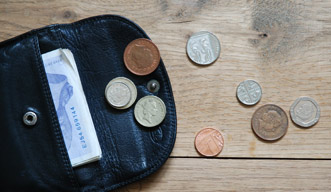
Gluten-free shopping on a budget
The wholefood shop is not a place in which my jaw usually drops, but drop it did this week when I picked up a bag of quinoa flakes that were £8.39, compared to £1.60 for the wheat equivalent.
Faced with a lifelong gluten-free diet, there’s not much you can do other than grit your teeth and get on with it, but the eye-wateringly expensive quinoa flakes snapped the cost of GF food into focus, and the fact that dietary compliance is something not everyone can afford.
We all know that Coeliac UK estimates that ‘following a gluten-free diet can bump up the cost of the average household shop’ and that ‘specialist gluten-free foods like bread’ are ‘three to four times more costly than comparable gluten-containing products.’
Basic GF items may have come down in price, but there is no doubt that the large growth in demand for GF food, and the premium price it can command, has lead to a surge in highly-priced products which are outside the reach of many coeliacs.
There are lots of reasons why specialist GF food is more expensive than ordinary food: the raw ingredients cost more; items often require a huge amount of research and development; special processing facilities are expensive and testing costs money. But if funds are already tight, having to pay extra for a GF diet is a hard pill to swallow.
So if you're coeliac and on a budget, how can you cut costs?
1. Make naturally GF foods the backbone of your diet - store-cupboard staples such as rice, polenta, buckwheat and potatoes are the cheapest carbs.
2. Read labels. EU legislation has levelled the playing field for processed food. All the allergens are highlighted, usually in bold, so you can read a label and see whether a product contains gluten or not. You don't need to look for something specially labelled ‘GF’.
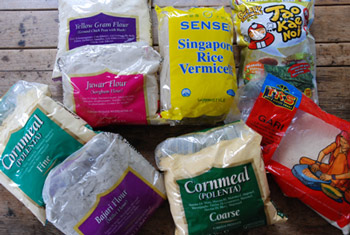
3. Large Asian-food shops are great for hard to find flours and bulk purchasing. The highlight of my visits to Nottingham is always the trip to the two rival superstores on opposite street corners. All the obscure flours you need for GF baking are available in sizes from 500g to many kilos: polenta, sorghum, potato, coconut, millet, gram, manioc/tapioca (think Pao de Queijo), and many types of rice.
4. Hunt for GF food in the normal food aisles. Supermarkets are doing really well at removing unnecessary gluten from many processed foods. There are lots of ordinary sauces, snacks and savoury items that already don’t contain gluten - and they’re sometimes a fraction of the cost of the GF alternatives you’ll find in the FF section.
5. Buy corn thins and rice cakes. They’re about the cheapest, readily-available, snacky carbs and they’re not full of fat, sugar and salt. Find them in the ordinary food aisles.
6. Fancy GF cereals can be mind-blowingly expensive. If you eat cereal, supermarket own-brands are the cheapest. (Some contain barley malt flavouring but at such a low level they’re still declared GF.)
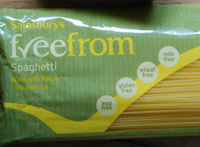
7. Buy supermarket own-brand bread and pasta. Lots are outstandingly good.
8. Snacks: plan ahead. If you can, take veg sticks, fruit and nuts, or energy bars for an emergency.
9. Don’t rely on finding food at motorway services. At best it’s expensive. At worst, there isn’t any. It’s safer (and much cheaper) to take something with you. Don’t be afraid to eat your own food whilst out - after all, it is a medical diet.
10. Whenever you cook, make double or even treble. Leftovers make delicious, cheap lunches.
And finally - yellow stickers! Very occasionally, GF food is reduced to the price of normal food. Buy it, freeze it, and enjoy at your leisure.
15th July 2015
The perils of takeaways...
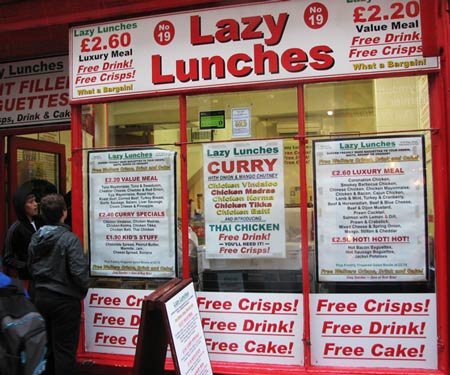
Thank God I’ve just got coeliac disease!
The news from the Royal Society of Public Health (RSPH) this week that most takeaway outlets have no idea what an allergen is, let alone if it’s in the food they’re serving, is shocking, if not entirely unexpected.
I don’t get takeaways anymore. Why anyone of sound mind would drive miles to buy something horrible, greasy and lukewarm to take back home is beyond me. But lots of people love them - my partner included - and I’d be happy to have one now and then just so I didn’t feel that my having CD had wrung every bit of pleasure from his life.
Where we live, far from a city, the only places even vaguely near - barring fish and chips - are a rubbish Indian that puts sugar in everything, a Chinese specialising in old oil, and a kebab shop. Apart from the fish and chips shops, I’ve never been to any of them, even before CD - and these days, what with the gluten inquisition, it wouldn’t even enter my head to try.
In Bristol I can remember takeaways were exciting and a treat, but having one was a rare event. Imagine, though, if you’re coeliac or allergic, young, male, and part of a culture where takeaways are places all your friends hang out. The RSPH report shows just how dangerous it can be to eat at most of them. In some cases, 100% of them had no record of the allergens in their food.
In this respect, I can’t help thinking that coeliacs are lucky. We might be ill and off work, but at least we’re not at risk in quite the same way as people with allergies, whose trips to takeaways could be life-threatening. Coeliacs make a lot of the fact that CD is actually an auto-immune disease, not an allergy or a food intolerance, and it’s true that if undiagnosed, it does come with a risk of other health complications. It’s serious, but food allergies and intolerances are dangerous and difficult to live with too, and indeed the former can sometimes be fatal. We spend so much time trying to differentiate ourselves from lifestyle wheat-avoiders that we often miss the fact that those of us who react to foods actually face the same battles.
It’s not easy being a coeliac, and although I can moan for England on the subject (and frequently do, my partner says) I rarely give a thought to anyone else’s intolerances. For a long time I believed CD was much more inconvenient and had more serious repercussions than an allergy. Now I have a slightly different take on it. Of the 20,000 people admitted to hospital last year with an allergy, 61.8% (12,560) of admissions due to allergic reactions were emergencies.
Takeaways need to get their act together fast, so we can all eat out safely, but they don’t just need more education about gluten, they need it about all 14 allergens too. Whether we have an allergy or intolerance, are anaphylactic or have an auto-immune disease, we’ll all benefit from the greater understanding our food regulations will ultimately bring, and until then we need to fight each other’s corner.
My local takeaway isn’t somewhere I’ll be trying anytime soon. When I rolled up out of the blue one sunny morning to ask the manager if they could do me something gluten-free, the answer was ‘No. Only Indian food.’
I’m grateful that there is only one allergen I need to avoid. When I think about those who have to deal with multiple allergies and anaphylaxis it actually makes having CD a little easier. There’s not quite so much riding on it for us.
19th June 2015
The big black marker.....
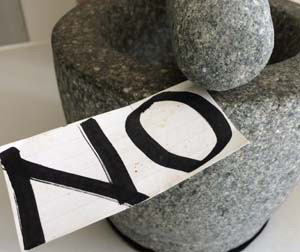
During the election campaign of 2010 I went out and bought the biggest black marker I could find. That evening a friend and I embarked on a mission to amend some of the Tory party signs that had sprouted at every road junction. It was a satisfying night, although I do remember ending up with spray paint on the door of my new car.
I was a bit too depressed by politics to bother with it all again this time round - but am pleased to say that my black pen is now enjoying more positive use in the kitchen.
Although never quite large enough for good graffiti, the marker is now usefully employed as the tool of choice for our range of warnings designed to stop me eating contaminated food. J seizes it at a second’s notice to joyfully announce with a big black cross that he’s contaminated the new jar of mustard, so I can’t have any. Sometimes I’m convinced he’s dipped his crumb-covered knife in there deliberately - indeed only last week he admitted labelling two unopened pots of yoghourt with the same black cross, determined to keep them both for himself.
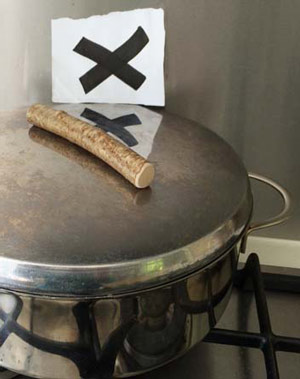
Jokes aside, this pen - the big black crosses on the lids of jars, and the ‘NO’ sticker - are what keeps me safe in the kitchen after all our other protocols have been observed. There are rules you see. His side of the kitchen. My side of the kitchen. His bread boards, our chopping boards. His nasty cloth, covered with crumbs (and never washed) and my nice clean one. Two toasters. His gluten cupboard stuffed with pasta, pork pies and malt vinegar. Mine full of out of date, half-price GF items. You get the idea. It works ? perfectly, I would say - as long as nobody else invades the kitchen and his patience lasts.
You see it’s all about trust, and the big black marker is the last bastion. It’s a belt and braces approach to upholding the protocol where all else has failed. J knows that if there’s a saucepan of something nice on the cooker I’m quite likely to stick my nose into it and eat some before wondering what it is. So the big black cross prevents me. It scares the hell out of me actually. It’s like Big Brother watching me.
Our methods work fine in a kitchen with only two people. Everything falls apart when other people are involved, and at this point I usually surrender, leaving the kitchen to the gluten eaters.
As I write this Genius announces that 25 of its GF products have been accidentally contaminated with gluten during production in the factory in Scotland. FSA allergen alerts and product withdrawals by big manufacturers are frequent occurrences, and contamination from smaller producers I’m sure must pass unchallenged or even undetected?you simply cannot eliminate all risk entirely. Just as in the kitchen at home, GF producers have to read labels, instigate protocols, demand backward traceability and do everything they possibly can to minimise it, only ? and quite rightly - for them, the responsibility is much, much greater. Almost exclusively, problems are the result of human failure somewhere along the line. Companies are only as good as their weakest members, and it’s often those at the very bottom who hold the greatest responsibility in their hands. Even the biggest black markers can’t prevent accidents happening and when they do it can take a long time to rebuild trust.
25th May 2015
Sue runs a tutored tasting of gluten-free beers
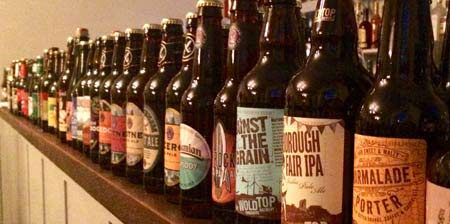
Later this year, but not too late, for the time is right now, we’ll put our bikes in the car and head to Cromer. I’ve grown up enough to reacquaint myself with the town where once I spent a miserable week’s summer-holiday, incarcerated in a stuffy Victorian hotel with a childhood friend and her parents, our only company another lonely child on her month-long annual stay in the temple of respectability.
That put me off Cromer for a long while, but a spark of interest has been rekindled and now I’m eager to return. I‘d like to cycle along the coast from King’s Lynn to Great Yarmouth, explore The Weavers’ Way, and most of all, buy beer called Ten Thousand Geese, Freshes Creek, Je Suis Charlie, and drink Saison sitting on the quay, eating crab as the sun disappears behind us.
The beers are the output of an extraordinary brewer, Martin Warren, who runs Poppyland, a small brewery in an old garage behind the town centre. I hesitate to call him a hobby-brewer, for the brewery is his business, but he brews tiny quantities of beer so unusual and unique that it’s the antithesis of anything you’ll ever find in a supermarket. More of Martin and his beer another time, for, although I’ve known of it for a while, I only tasted it for the first time at a beer event we ran last week.
There’s such a large range of GF beer around at the moment that Kim McGowan, who puts on GF events through her company Gluten Free Gathering, thought the time was right to run a proper gluten-free beer-tasting. It took place at The Truscott Arms, with a fine meal afterwards, to soak up all that booze. Although the main event was a tutored blind-tasting of 8 beers, we also tried some of the other 60-plus GF beers on the market, including, for the first time, some of Martin’s.
(You might be wondering how come there are suddenly so many GF beers around, and it’s a good question. Ordinary brewers sometimes add an enzyme to their beer in order to stop it going cloudy when it’s cold. A serendipitous side effect is that it also breaks down the gluten molecules so the beer tests gluten-free. This accounts for the bulk of the new GF beers.)
The beers we tasted and talked about at the event were craft beers, produced by small breweries with capacities far below that of the giants. They were a delight, and ranged from the lightest, most refreshing bitter, to the deepest, darkest, stonking-great stout. Yes, a GF stout. It’s so new that we hadn’t even tasted it before we flipped off the top and stuck our noses into its velvet depths.
Back home in Dorset after the tasting, I went to the fishmonger, and bought a crab. We ate it accompanied by a glass of Martin Warren’s Je Suis Charlie, a very special, barrel-aged Crab Saison, named after the events that took place on the day of its bottling. It’s an extraordinary beer - I’m tempted to say sublime, but I need to try a lot more of it before I confirm that declaration. Hence the trip to Cromer with our bicycles.
25th April 2015
Women's Institute Teas....
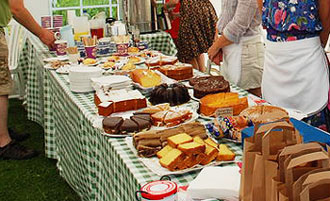
If I go out for the day
there’s something way more important than what to wear. It’s what I’m going to eat. Snacks will need making. Sometimes I’m late
because of the magnitude of the task It. After all, 8 hours with no food is a long time in my book.
The country fair I go to each spring is one of those places where there’s never anything to eat. I take my own food, lots of it, to make sure I feel happy when everybody else is eating bacon butties and cake. Cake made by ‘the legendary WI.’
Legendary they might be, but GF hasn’t yet made an incursion into their repertoire at this event, and although the tea tent is a major draw - a chaotic marquee, packed with customers all day long and supplying breakfast, lunch and a huge array of cakes - I usually skulk outside with my bag of food.
But this time my friend came out red-cheeked with excitement, ‘They’ve got gluten-free cakes this year and they look amazing!’ she said. ‘You’ve got to go in.’
Reluctantly I did. It was the usual gluten-fest, and it didn’t look good. (True, there was a container of GF fairy cakes, but who wants a bloody fairy-cake?)
‘That one’s GF’, shouted the cashier who’d taken me under her wing, pointing to another container. Indeed, there was a cake in there, half on its paper plate, surrounded by a haphazard arrangement of things that clearly weren’t GF – bowls of apple pie and custard and what looked like cheese pasties. ‘But you can’t put those…’ I started to say, before realising it was pointless and shutting up.
So I proceeded to the cashier, sans cake, but she was still keen to help. In fact she made it her mission. ‘There’s one of our bakers, she confided, waving her hand vaguely in the direction of the counter, ‘she thinks even vegetarians are fussy eaters’. She roared with laughter. I kept shtum. I thought if I hung around any longer she’d spot I was a veggie too. ‘Sheila, Sheila,’ she yelled – ‘there’s some more of those cakes under the counter. Get a new one out for her.'
A new one was found and, when requested, a clean knife procured. I ate my giant slice outside in the sunshine with my friends, after I’d finished the soup that the Chinese whisper of WI ladies assured me was also gluten-free. It wasn’t long before I realised there’d been a mistake.
Either could have been the culprit - I’d eaten unlabelled soup and cake made by persons unknown, with unknown ingredients. Pretty stupid. It can be tempting to believe a person in a pinny when they say something’s GF but sometimes it’s best just to walk away.
During the week it took me to recover, I wondered how, within the utter chaos of this event - run by non-professionals and volunteers - they could even begin to address the requirement of the Food Information Regulations, so I checked it out. The answer is they don’t. ‘Individuals who are not food businesses and occasionally provide food at charity events or voluntary cake sales, for example, do not need to follow the requirements of the Food Information Regulations.’
It was obvious from the start the tea-tent wasn’t a safe place to eat. They couldn’t possibly provide GF food there. And that’s absolutely fine by me. I was careless. Maybe, at the back of my mind, I thought we had a little more protection against the accidental consumption of gluten. We don’t. If The Food Information Regulations are in force, they will help us make safer choices, but in themselves they don’t confer safety. That’s still down to us.
26th March 2015
A strange inheritance – muesli and kefir...
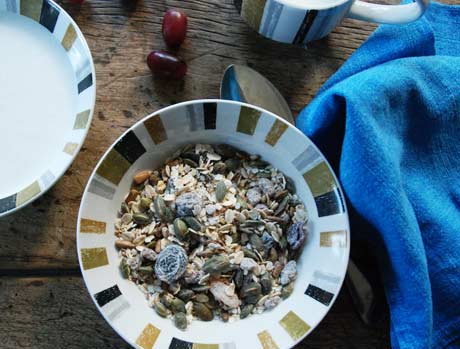
Sometime at the end of the 1970’s when I came
home from university for the summer, I found my father in his shorts, sitting cross-legged on the lounge floor with his girlfriend, eating supper from a tablecloth spread on the carpet. It was a bit of a surprise. I recognised the tablecloth but the Antipodean sitting opposite my father was new. These were the days he used to make his own muesli. It seemed such a massive undertaking. Why he did it I could never fathom. Surely it was crazy to go to all that trouble mixing muesli in the bath when you could buy perfectly decent stuff in the wholefood shop.
Now it’s 2015 and I’m doing the very same thing -
making muesli, that is, not eating on the floor. I was reluctant at first, still channelling adolescent rebellion against the 1970’s San Francisco counterculture that seemed to permeate our house, but now I don’t mind it, mainly because I’m a sucker for nice food and muesli’s something I eat every day. Although I don’t make mine in the bath, I can see I’m beginning to take up my father’s most annoying habits - despite my best efforts.
Why bother making muesli? The wholefood shop’s GF version is a dusty, dull affair with nothing to recommend it. Probably my father’s reasoning too, just without the GF bit. I even quite enjoy the process now; the irresistible smell of toasting seeds, extra handfuls thrown in to eat whilst still warm, the snip of apricots, the big flame raisins, and at the end, a huge sweet-jar full of cereal.
I might not own a Mark 1 Scirocco with an oil gauge from a shot-down Seafire, or wear inconceivably-small shorts tied up with a purple belt, but my muesli, just like my father’s used to do, accompanies me on trips away. No longer in a grimy Tupperware box, it’s portioned into bags for breakfast, sometimes doubling as dinner as well, if there’s nothing else to eat. And unlike the wholefood shop’s, mine isn’t just a miserable bag of grey-looking rice flakes.
Although it’s now a different century, and I live 200 miles away, my kitchen still resembles the one I grew up in; sweet jars full of muesli, lentils, rice, and - to complete the picture straight from the 1970’s Whole Earth Catalogue - a bowl of kefir on the side. Kefir came into my father’s life about the same time as the visiting Australian, who didn’t last long (it was probably the shorts), but the former survived everything that was thrown at it, including my reluctant and unrequested guardianship at the very end.
I hated kefir and its scary sponge. It was always there, in the kitchen, sitting quietly at the back of the worktop near the boiler, something too awful to contemplate. I loathed the fuss of preparing it, never even letting it pass my lips, but now I make it every few days in the very same ritual that punctuated my father’s life.
It’s taken me 30 years to admit, but my Dad had food sussed. ‘Sue doesn’t like my kefir,’ he’d goad, when his weird friends were there. But I do now. I’ve changed my mind. He was onto something good.
28th February 2015
If you need a friend
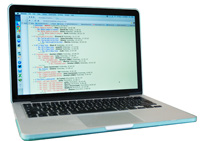
When you’re first diagnosed with CD it feels as though the world as you know it has come to an end – and in a way it has. It’s not hard to get used to the new one, but the journey can be lonely and it’s nice to have some company along the way.
There’s a website that helped me back then when I was new to it all. It’s called The Coeliac DH and Gluten Free Message Board.
Run by a group of volunteers, known only as ‘admin’, the board is a forum on CD. I’ve never met anybody on it, but you can be sure, whatever your question, that there’ll be people there who know the answer.
Look at the site regularly and you’ll get to know people with similar views, people whose posts you’ll want to read.
If you’re the mum of a newly diagnosed child, or the parent of a toddler who’s been ill for ages and whose doctor isn’t clued-up about CD, there will be people on this board to help and advise. Some of them might know more about CD than your GP. On the board you can rant and rave to your heart’s content and somebody will always respond.
Everybody knows the first few months after diagnosis are the very worst times. You walk out of hospital or your GP’s and don’t know where to turn - which food you can eat, what to have for supper even. The dietician’s appointment might not be for weeks, but the board will help you straight away.
The newly diagnosed regularly post messages and I‘m always impressed by the help and support they receive. As time goes on you see them growing in confidence, then starting to help newcomers themselves. So the board perpetuates itself. The questions might be the same but the people answering change.
A board like this doesn’t just happen. Moderators, people working behind the scenes, run it. They make sure people abide by the rules and aren’t too nasty to each other when there’s a disagreement over things like Codex wheat, malt vinegar or dextrose.
There are as many opinions on the message board as there are people, and that’s its strength. Once you’re skilled enough to survive on your own you might only need to dip in and out once in a while, but often people stay, sometimes for years.
Unusually, this board doesn’t take paid advertising. It’s a source of frustration for some, but I think it’s a plus. The board’s about people helping each other - school trips, places to eat, Yorkshire puddings - the everyday stuff. It’s amateur, in the very best sense. Adverts are there, but they’re hidden away. You can find them on the GF Suppliers List, but on the main page of the board there’s no selling. Periodically the moderators have a fight on their hands over this and a few times it’s looked like they might give in, but I’m thankful they haven’t had to.
There are a few glitches. New topics go to the top, so additions to older posts are never seen - but this is the only big one. The board’s not trendy; it’s not big on paleo, FODMAPS or raw. You might think it a bit old-fashioned. It never pushes itself, but it’s a welcoming community and it feels nice to wander in and catch up every now and then. The problems might be the same ones - a child too ill for a gluten challenge, queries about Bisto, pictures of someone’s first GF cake - but if you’re fresh to CD or just struggling to come to terms with your diet, give it a look. What you can be certain about is that whatever your question, or experience with CD, someone on there, possibly someone like you, will understand and take the time to answer.
31st January 2015
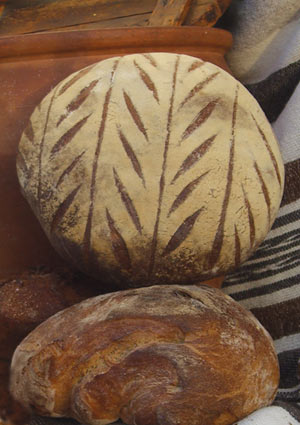 Bread....
I’m nuts about bread. Before I knew I had CD and was
destined to a miserable life without the best food in the whole world, bread was my thing. I made it almost every day. It must be genetic, hard-wired into my soul. I’m the daughter
of a bread fanatic - a man who made a 3lb batch of rye every
10 days for most of his life until he was 93 and could barely lift the mixing bowl anymore.
Eventually I grew up to make bread as well; sourdough, rye, focaccia, overnight loaves - I
just loved it. I made it for me,
for friends, to take to people’s houses. That yeasty smell, the texture, the taste - I can still think of nothing nicer. And yes, before you ask, I probably did eat a bit too much, and no - it didn’t give me coeliac disease. That particular legacy’s an enduring gift from the other side of the family.
I could never be one of those annoying people who say they just don’t miss bread. How can you not miss something that’s part of the very fabric of existence? I miss it like mad, I just try not to think about it more than about a hundred times a day. Bread is fundamental. It’s nutritious. Eating it is part of an age-old ritual of daily life. I could probably drive myself crazy thinking about its chewiness and the heavenly spring of comforting, yeasty wholesomeness.
Thankfully over the last 10 years GF bread has blossomed from a strange, medical product to a convincing imitation of supermarket bread. Like most processed food, it tends to be high in fat, sugar and salt, and has a list of ingredients much longer than the flour, yeast, oil, water and salt you’ll find in real wholemeal bread. On the plus side, it’s extremely convenient, toasts properly and is well-behaved in sandwiches. It’s lead to a great revolution in GF take-out food. It’s a technical triumph; a perfect look-alike product that’s made life a lot easier for us, our families and anyone who ever caters for us.
But still I long for staff-of-life bread - the tang of sourdough, the smell of an overnight loaf - and deep down I hope there’ll be a miracle and someone will create a GF bread that’s as pure, as tasty, and as healthy as the real stuff. Andrew Whitley’s ‘Yeasted Gluten-Free Bread’, from the chapter on gluten-free baking in Bread Matters, was my first success at making bread that tasted good, and I made another equally delicious ‘Buckwheat Cheaty Sourdough’ loaf on a gluten-free baking course at River Cottage with Naomi Devlin a few years later. But now I mainly eat too much of a weird-looking, dense block of bread that’s as heavy as a house brick. Nobody’s ever heard of it and friends look in pity when they see me eat it, but it’s reasonably healthy and has a good, sour taste and a chewy texture after toasting. I think of it as a coeliac’s pumpernickel. Barkat Wholemeal Sliced Bread looks like a product from the 1950s. It desperately needs rebranding (and I keep telling them so) but the ingredients - whole rice, millet, whole maize, rice flour, water, sweet lupin flour, guar gum, xanthan gum, salt and yeast – are pretty good for a gf bread, and the fat content per slice is only 1.1g - a little higher than ordinary Kingsmill 50/50 at 0.9%, but still low for GF a bread.
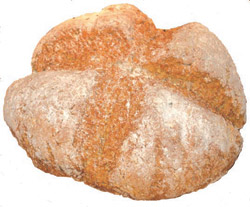
If you really can’t bear life without bread you could always try this. Someone once told me of their way of getting to sleep when nothing else works. It’s a bit like the meditation exercise where you go on a favourite journey, remembering all the sights and sounds you experience on the way to a special place. My friend’s destination is the inside of a loaf of wholemeal bread. When you get there, after your walk through dappled woods, you curl up inside the soft, warm, yeasty wholesomeness and fall asleep. I can recommend it. It’s the only way I can experience the pleasure of real bread without actually eating it.
3rd January 2015
Run down on 2014...
• Number of accidental glutenings with consequences = 0
• Number of planned glutenings with consequences = 0
• Bottles of beer consumed and subjected to rigorous analysis = 71
• Bottles of beer consumed for unadulterated pleasure = 365
• Number of half-price bagels past their sell-by-date and consumed late at night with butter and honey after overindulgence in beer = 24
• Number of meringue roulades made for friends instead of disastrous cakes = 18
• Number of wasted yolks = 118
• Number of times I’ve been out to a café and watched partner eat chip butty/ giant cake plus the biscuits which came free with my coffee = too numerous to count.
• Number of times I’ve been to a café and had something to eat whilst my partner looks on hungry = never.
• Contribution in GBP to the 2014 quinoa shortage = £320
• Happiest eating-out experience: Love in a Cup near Frome, which is totally GF and you can eat everything in the whole place, which I did.
• Worst eating out experience: waitress, ‘OK, I’ve just checked and all you can have is the green salad without the dressing.’
• Least favourite shopping trip: to the local post office to buy nice bread for partner who has no idea of the extreme generosity of spirit this requires.
• Most exciting supermarket visit: Sainsbury’s in Taunton, where the FF food aisle was gigantic.
• Prize for most revolting GF item ever: ‘Toaster Pastries’. Do not let them soil your lips.
• Favourite place to visit: our best friends’ - who indefatigably read labels, come up with exciting things to eat and always seem pleased to see roulades.
• Worst food experience: junk-food buffet lunches at work where every single item contains gluten or you can have an apple instead.
• Most dreaded sight in friends’ houses: breadcrumbs and bits of toast all over the worktop.
• Usual state of our house before diagnosis: breadcrumbs and bits of toast all over the worktop.
• Best line from chef, after long in-depth explanation about coeliac disease and gluten: ‘And there’s those other what-are-they-called kwerliacs aren’t there?’
• Most unfortunate line from waiter: ‘I hope you don’t mind me double-checking this but last week someone ended up in A and E.’
• Silliest mistake: taking bite of partner’s toast after he had accidentally swapped position of plates on worktop.
• Best party-question: ‘Do you still have the packet for those crisps?’
• Least favourite comment: ‘I’d kill myself if couldn’t eat sourdough*’/pizza*/anything else remotely nice.
• Question most likely to lead to a feeling of disappointment: ‘Are the chips cooked in the same fryer as everything else?’
• The number of times before diagnosis I would ever have wanted chips = 0
• Success rate of acquired skills: feigning lack of interest in bread products 2/10; loving cider 6/10; pretending to be too full for pudding 9.5/10.
• What I would eat with 2 hours’ notice of impending death: bruschetta, followed by granary from post office, above; pizza; pisaladière; Portuguese custard tarts.
• The good things about having a partner with CD (from reliable source): ‘Now I can eat all the bread and the cheese pasties and don’t have to share anything.’ (sic)
The bad things: ‘It’s ruined my life and I’m sick of that roulette you make.’
Wishing you a happy, healthy, year with an intact sense of humour and a handbag full of cake.
From Kate:
Can I just tell you how much I love this diary! So well-written, so funny, so familiar. Thank you, Sue, for writing it. It is one of the things that makes me feel better in my daily battle with a world apparently full of breadcrumbs!
And Tweeted:
• I loved your diary - so familiar except I wish I could keep my sense of humour when faced with starvation or plain lettuce.
• Just read your diary, love it! I'm a coeliac lactose intolerant, it's a nightmare!
• Just read your 2014 diary. It made me laugh, but also as a fellow coeliac I feel your pain.
29th November 2014
Are we being too optimistic about freefrom food?
If there was ever a time to be optimistic about eating out surely it’s now. We’ve just had the first FreeFrom Eating Out Awards, new regulations are falling into place for cafes and restaurants, food manufacturers are jumping on the free from bandwagon like commuters piling on to a rush-hour train. Gluten-free is a trend and celebrities of all kinds are suddenly endorsing our limited food choices. What’s not to like?

I like it. I really do like it. It’s just that out there,
in an all too familiar scenario, wandering round trying to get a bite to eat at 8.30pm in any of the cafes that line Waterloo’s concourse, not much of it yet seems to have fed through to the high street. And sorry, I don’t want to be a doom-monger, but I do sometimes wonder whether, despite all the hype and optimism, things really are going to get better.
Walk into M&S, Costa, Pret, Starbucks, Nero, Wasabi, in need of food and it’s still a pretty hit or miss affair. Yes, some of them do stock gluten-free wraps or sandwiches but will they actually have any when we want to buy them? Might all those people who maintain that freefrom is just another diet/food fad be right - could coeliacs end up back in that old life when we never even entertained the idea we might find anything to eat outside the house? Full marks to the small independent cafes that have embraced the idea of gluten free. If you’re lucky enough to be near one you’ll find an incredible offering of good food. But too many of the big chains, where most of us have no choice but to buy snack-food when we’re in a hurry, are still stuck in a mind-set where they think a pile of chocolate brownies ticks the ‘fussy-eater’ box. Are these companies really ever going to be a reliable source of food? And if all those 'lifestyle' wheat-avoiders (on whose backs we’re all riding at the moment) do move on, then what happens to those of us who actually need the free-from foods that they were just 'choosing' to eat?
There simply aren’t enough of us who need special GF snack-food to guarantee that we’ll be able to find it when we need it. We live in a country where gluten - bread, pastry, dough and batter - forms the basis of pretty much everything we eat on the go. And more than anything else, it’s Food to Go that’s the problem for coeliacs. Restaurants are getting better, but cafes, pre-stocked with food made elsewhere, are a lottery. If you eat gluten and you need a sandwich, even if there isn’t one, you can substitute a wrap or a bagel. If your only hope is a GF sandwich and there isn’t one – then you’ll be going without supper again.
But there is another option. I’m thinking of already existing snack-foods, which, with a tiny tweak, would be gluten-free. Sushi is one; popular, ubiquitous, it could easily be gluten-free with the substitution of tamari for soy sauce. Soft corn-tortillas are an alternative to wheat-flour wraps without a hint of ‘special diet’. Portions of tortilla (Spanish omelette) are already a popular tapas dish over here. I’d be happy if I could buy these in any Pret, M&S or Costa. I’m not saying there isn’t a place for special GF items - they’re great, as long as you can find them when you need a quick bite. But if we change our focus and look at small tweaks to popular, mainstream snacks that are already almost gluten-free - and on the shelves in large quantities in cafés all over the country - then we might discover some savoury food we could rely on, and I could ditch my flippin’ rucksack.
If you wish to comment on the issues Sue raises, click through to our Facebook page here.
18th October 2014
We’re trying to work out how much gluten’s in my lunch but all I really want to do is eat it.
If you mention ‘parts per million’ when you’re talking about your diet even your best friends’ eyes tend to glaze over. But people often want to know just how much gluten you can eat before you get ill, and they expect an answer they can understand, something along the lines of ‘a fraction of a breadcrumb’ or ‘a microscopic piece of pasta.’
Parts per million is particularly hard to grasp in relation to food because it’s a measurement that’s more at home in the lab than your lunchbox. 20ppm of gluten is 0.002% gluten. Either way, neither means much to me, but crucially this is the food standard by which anything labelled gluten-free has to comply.
Assessing just how small a quantity of gluten will make us ill is a tricky thing to do. You need a large double-blind study of long duration, with many participants. Only a couple of small studies of merit have ever been done. One recommends that we keep our intake of gluten to below 50mg per day, whilst another implies we’ll be safe if we keep it to under 10mg.
The application of ratio in my life is usually limited to making meringues with 4 egg whites instead of 5, or mixing small quantities of cement. In terms of gluten I don’t do calculations, I just glance at packets and eat, safe in the knowledge that anything under 20ppm’s fine. So working out the amount of gluten in my sandwiches as a fraction of the daily limit is going to take some time. Fortunately they’re not toasties. I have a pen, some paper and 4 slices of bread at 6ppm. I fetch the calculator and a mathematician.
Having to do fractions does not endear me to my lunch companion, but finding out how much gluten I’m eating comes as a bit of a shock. After weighing the bread and working out my portion size, the sandwiches emerge at 1.15mg gluten, just over a tenth of the daily limit. But surprisingly, if I were to drink 4 bottles of beer at 6ppm, this would take me way over the 10mg limit and leave no room for any other gluten-free items at all.
So parts per million, the standard for our food, is only relevant in tandem with portion sizes; they go hand in hand. Otherwise there’s no point in comparing the ppm of a bottle of beer with that of a stock cube when you’ll drink several of the former at one go but consume only a fraction of the latter.
We all try to eat healthy food and, apart from a bit too much in the mayonnaise department, I probably don’t do too badly. When we eat out most of us worry about the risk of cross-contamination but it seems to me there might be another risk, much nearer home, if we rely solely on ppm as the safe way to judge the gluten-free foods we consume in high volumes.
18th September 2014
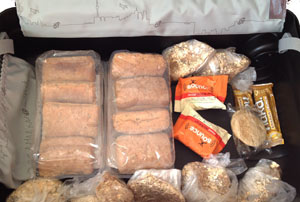
Packing for the hols
Packing everything you need
for a week’s holiday into a small item of hand luggage is always
a bit of a squash, particularly if you’re taking food with you as well. And if you’ve never visited the place before you can’t be sure how much you’re going to find to eat.
Sometimes, if I fear the worst - that there’s not much room left for clothes, in my case. Although I love fresh food and wandering through local markets, trawling about looking for non gluten-containing carbs is not what I really want to do on holiday, yet I still need to eat.
Sick of hand luggage that’s over-weight because it’s full of muesli, before I flew this time I contacted RyanAir to ask whether coeliacs are allowed an extra bag for food items. They said yes, I could have an extra bag, of specified weight, for items of food if they were medical supplies. All I had to do was print the special waiver letter they emailed me, and present that, plus a doctor’s letter, at check-in. (I just took the consultant’s letter of diagnosis, stating that I would have to follow a gluten-free diet for life.)
In the end I actually managed to squash everything into my existing luggage and didn’t need to take another bag, but it was nice to know I had the paperwork that would save me the fee if I’d been forced to put my over-size rucksack ‘handbag’ in the hold.
Sometimes - quite often actually - food is just fuel. If I’m going walking, all I want is some easily transportable carbs. That's why I took the supply of gluten-free rolls on holiday. I know it sounds pathetic taking food to another country - as though I’m scared of eating anything foreign - but it’s just that time away is short and I’d rather be climbing down a cliff to a deserted beach with my squashed roll from England than searching hopelessly for a rice cake in a foreign supermarket.
Of course sometimes there are wonderful discoveries, mostly made by others. I don’t even bother to look half the time. In Beziers this year, after he’d been told not to buy bread, J came back from the local wholefood shop triumphantly clutching what turned out to be the best loaf of gluten-free bread I’ve ever eaten. He said it was the way the shopkeeper picked it up and proudly showed it to him, carefully using a sheet of paper so as not to contaminate it, that made him take it. He knew it looked special. 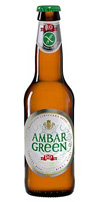 That dense seeded-loaf did me several lunches and the stale, slightly mouldy crust, combined with olive oil, lemon zest and a little Demerara sugar, became the topping on my apple charlotte (which looked nicer than the tarte tatin the others were making). But I would say that. That dense seeded-loaf did me several lunches and the stale, slightly mouldy crust, combined with olive oil, lemon zest and a little Demerara sugar, became the topping on my apple charlotte (which looked nicer than the tarte tatin the others were making). But I would say that.
And as we burst through the supermarket doors last week searching for breakfast on our first morning in Ibiza, my friend spotted a towering pile of Ambar – the gluten-free beer – at €.82 per bottle. The holiday had got off to a great start.
23rd August 2014
Could eating out become a pleasure rather than a pain?...
Much as I love eating I always dread going to places I know nothing about. Not just because I’m negative and whingeing, but because of that routine you have to go through each time.
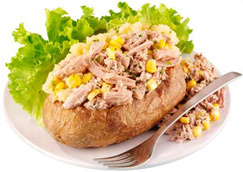
So I’m really looking forward to the new food regs for cafes and restaurants. I hope they’ll make eating out a lot easier. The investigation needed to identify the ingredients in the topping on my potato at lunch yesterday made me wish I’d just brought along my own sandwich.
‘What’s Appetize Spread?’ I asked the woman behind the counter. ‘Is there any gluten in it?’ She took me over to the cabinet to show me a potato with Spread on it. ‘Bacon or herbs.’
‘Ah,’ I said. ‘I need to know what’s in it.’ She stared blankly at me. ‘What does it come in?’ I said helpfully. ‘If you bring me the tub I’ll have a look at it.’
She gestured at a stack of cartons on top of a fridge. ‘It just comes in them.’
‘OK, I’ll have a look at those then.’
‘It doesn’t say anything on the box,’ she said.
‘Surely you must be able to tell me what’s in it?’ She disappeared into the kitchen and came back with a tick list for the meals. There was only a limited choice of ticks – dairy, nuts and wheat - but happily nothing against wheat for my potato and its spread.
‘OK I’ll have that then,’ I said, noticing it came with crisps and salad.
‘Are the crisps gluten free?’ She handed me a packet, clearly labelled, ‘no allergens’. ‘Are these the crisps you serve with the jacket potato?’ I said, suspicious. She nodded. ‘Well I’ll have those then please,’ I said. ‘And what about the dressing? Is it from a bottle?’
She went off and returned with a giant bottle of vinegar. ‘Is it just this on the salad?’ I said. ‘Or does it come with something else too?’ She didn’t know. ‘But you can have it without dressing if you want.’
My jacket potato with tuna fish, crisps and undressed salad came as jacket potato with tuna-fish-in-some-sort-of-mayonnaise and salad with dressing (plus a rogue piece of salami under the crisps). I hadn’t checked the tuna fish because I stupidly assumed that tuna fish meant, well…just tuna fish.
I took a chance and ate my meal but, by law, after December 13th restaurants will have to be able to let customers know which specified allergens are in the food, and not just shrug or supply a few ticks against random ingredients.
I live in hope that, eventually, the long-winded, to-ing and fro-ing to find out what’s in your food will become less common, and eating out won’t be such a hassle for all concerned, including the restaurant. It’s not great to be at a lunch meeting and have to ask the manager to bring an industrial-sized tub of dressing to the table so you can pore over the ingredient list whilst your colleagues sigh and roll their eyes. (It’s not great that the manager doesn’t actually understand what gluten is and can’t answer your question himself, but that’s a battle for another day).
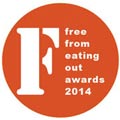
(Sue will be on of the judges for our new FreeFrom Eating Out Awards which will reward 'eateries' of all shapes and sizes who can 'get it right' for coeliacs and food allergics.
The awards close at the end of this month and will be
presented in November, just before the new regulations come into force. Check in here for more information.)
26th July 2014
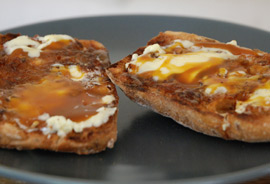 The Marmite issue
When a friend called me to say
she was so hungry after the party we’d been to that she’d had toast
and Marmite when she got home, I laughed and said I knew what she meant, but inside I was a little sad I couldn’t do it too.
Marmite is instant comfort food. For most of my grown-up life it was my snack of choice. If I got back late and hadn’t eaten, I’d have toast and Marmite.
It was the perfect after-party supper. It was my breakfast every day, my daily fix of umami. If I was too lazy to cook and just wanted to collapse on the sofa, I’d eat toast and Marmite. For those of us who love it, Marmite is a soul-food; mention it and you instantly share a common bond; a bond that for me now only exists in memory.
It took me a long time to realise I couldn’t eat Marmite. Back then, in my old life, I vaguely knew it was a by-product of the brewing industry, but in 2007 conventional wisdom said Marmite was OK and Coeliac UK listed it in their bible, so I continued to eat it. It was only a couple of years later, still with symptoms, that I worked out by a process of elimination that Marmite was the cause and gave it up for good.
Now I know, officially, Marmite is NOT gluten-free, even though a lot of coeliacs believe it is – indeed most of us looking at the label would wrongly assume the latter – simply because there isn’t a gluten-containing cereal on the ingredient list.
But the yeast extract in Marmite is derived from barley and tests show there’s approximately 60ppm gluten in the final product, although because barley is not a ‘deliberate’ ingredient and micro-organisms are exempt from the allergen labelling provisions, it doesn’t need to be declared on the pack. Yes, Marmite conforms to the labelling regulations, but by virtue of its unusual composition it’s in one of those grey areas where the broad strokes of the law don’t actually help those people trying to avoid a particular allergen.
So now after a party I collapse on the sofa eating Vecon or Essential’s Yeast Extract instead. Both are tasty and neither contains gluten. It’s so long since I’ve had any Marmite I know I probably wouldn’t even like it anymore, but it’s a symbol from my old life and when it’s mentioned I still feel a pang for a food I can no longer share.
28th June 2014
Feast or famine? Sometimes we all get it wrong.
Tuesday. Supper. Tupperware box of sandwiches and a carrot at service station.
Wednesday. 6am. Wipe breadcrumbs out of hotel cereal bowl and eat own muesli. Arrive at work grumpy. Nothing to eat at work apart from industrial quantities of gluten.
11am. Day goes rapidly downhill when have to spend most of it in en route across London and back. Make catastrophic error and forget emergency supplies. Sit in traffic for 2 hours. Arrive late with no time to hunt for food.
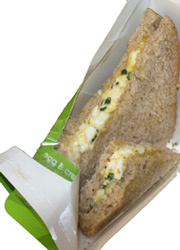
5pm. Hungry. Call home in bid for sympathy but nobody in. Finally stop for lunch at Tesco Metro and look for gf sandwich. Ask staff for gf sandwich. Nobody knows what a gf sandwich is. Refuse to believe there isn’t one. Look again. Staff decidedly unhelpful. Resignedly buy tub of pineapple and packet of Doritos and eat them in petrol station over the road and swear at man who’s blocked me in. Wonder if Tesco even does a gf sandwich. What does it look like? And how do you know where to find one if staff don’t even understand what they are?
7pm. Finish 4hr crawl across London and arrive back at work having missed drinks party. Drive to large supermarket to continue unsuccessful quest for sandwich. Purchase hummus, a red pepper and a giant packet of Doritos. Eat supper sitting in underground car park whilst mentally composing ranting letters to everyone.
Thursday. Awake feeling sorry for myself and hungry. Eat own muesli at hotel breakfast. Work ‘til lunch. Consume uneaten piece of red pepper and remains of hummus from car park the night before whilst standing at window watching everyone else return from Sainsbury’s Local laden with nice-looking prawn sandwiches and gigantic pain au raisin.
Stomp round to Sainsbury’s myself looking for anything edible and accidentally stumble across gf sandwich. Am delighted. Eat it all and immediately go back and buy another and eat half that too. Return to work remarkably happy.
Friday. 6am. Awake somewhat dejected at food situation but pleased I might be a bit thinner. Eat own muesli again in hotel. Consider asking for refund for breakfasts. Try to remember what I ate at last proper meal on Monday night, but fail. Work until desultory lunch of 3 rice cakes, 2 apples and a banana. Contemplate remaining half of yesterday’s sandwich but decide will need it for supper. Watch colleague eat large take-out pasta salad and hate her.
6pm. Stand on street looking bewildered trying to find bus. Sympathetic driver takes pity on me and gives me free ride to right bus stop. Wait, clutching somewhat battered half-sandwich, observing streams of eating commuters. Get on bus and promptly fall asleep. Wake up and spot Honest Burgers sign disappearing past window. Crane head round. Big red light flashes in brain. Grab bags and stagger back to Honest Burgers. ‘A table for one, madam?’ Sit down to gf veggie-burger, chips, roll and beer.
Leg it to St Pancras. Sit on train flushed with success and immediately eat other half of sandwich.
31st May 2014
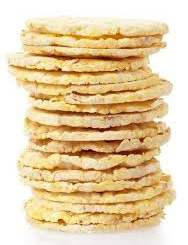
Share my food? No way...
I’m simply incapable of sharing with good grace.
Or indeed any grace, come to that. Sometimes I wonder if having coeliac disease has made me more selfish, or if I was always going to turn out mean.
Take me out of the house for a while and my only concern is whether there’ll be any food. I try to hide it, but however exciting and wonderful the day promises to be, I always harbour a nagging fear I won’t get anything to eat. And quite often, unless I take my own food, I don’t, which brings me to the alien concept of voluntarily sharing it with anyone else.
If I work away I always take a big bag of emergency supplies with me. Feeling I ought to share them is not usually a problem that arises in the UK, as colleagues look on corn thins as insulation material rather than a source of carbohydrates, but having been up since dawn with nothing to eat on an uninhabited island off the African coast, even foods previously perceived as unattractive can acquire a sudden desirability.
So sharing food can become a bit of a thorny issue, particularly if we’re somewhere remote and I’ve taken a bag of emergency provisions to last me the job.
I went away last year with 68 corn thins (calculated at 4 per day, with 8 for flight days and 4 spares, just in case), a few snack bars and some packets of almonds and apricots, and I didn’t fancy handing them out in the back of the car when the hulking great junk-food addicts were all feeling a bit peckish after their bag of biscuits had run out, especially as I knew they’d be chucked out of the window as soon as anything better turned up.
Thus, although in theory I’m committed to the concept of sharing, and love nothing more than the idea of a big communal meal, in real life I don’t really like doing it. In practice it never quite works out. I suppose it’s a bit like being a veggie, going out for supper and finding all the carnivores want the meat AND the veggie option too. A bit like that, but not quite, as you can choose whether you’re vegetarian or not.
And of course I blame CD entirely for my occasional catastrophic lack of manners, even downright rudeness. Last year I met a long-lost relative for coffee, spotted a gluten-free cake on the counter, bought it, sat down and had eaten it before I’d realized I hadn’t even thought to get him anything. It was only when I put my fork down and saw him looking at me I realised what I’d done. You see mostly I don’t care about other people and their food. Which might be just as well, because I often get the impression the feeling’s mutual.
Comment from Ruth of Ruth's Allergy Diary:
I am completely the same. I don't care two hoots about anyone else's food, and I certainly won't share. No way. I find it really hard to come home and find my gluten free bread gone, only to have the stealer complain it was awful! Who would buy this stuff? Me! And the contamination of marmalade is one of my biggest bug bears. My favourite lime marmalade, only just opened, fell foul of one of those incapable of using the spoon. Same with the hummus. Home made and now ruined by your butter knife or breadstick.
I am that child who will not share the toy. No way. Not happening. The oat cakes are mine and the dairy free chocolate? You can starve. And no you most definitely cannot share my bottle of water you allergen guzzling people you!
3rd May 2014
Guests mean gluten.....
Am preparing for an onslaught of guests. Guests mean gluten.
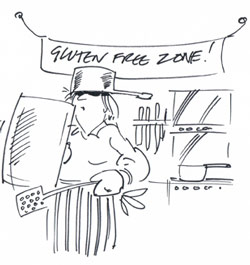
The safe, reliable house will be transformed into a danger zone where I’ll be reduced to the status of an interloper.
Yesterday evening I sneaked a bag of crisps from the cupboard, ripped the top off, and ate as many as I could before J came in. (I have to do this or he eats them all.)
‘You can’t eat those,’ he said. I stopped chewing for a second. The subsequent look told me he was joking but the point was that I hadn’t even bothered to check. I didn’t need to. At home he knows I’m liable to eat anything that’s lying around, without even thinking about it. So the bad things in our house are either hidden where I won’t find them (usually somewhere high), reside in his gluten cupboard with all his pasties, or are marked with a huge skull and crossbones.
But this weekend all of that will go out of the window and I’ll have to look after myself. Gone will be MY side of the worktop where nothing with gluten ever touches down. Breadcrumbs will be over every surface; knives, cheese, chopping boards, half lemons, anything left out anywhere even for a nanosecond will be covered with the stuff. The kitchen will be a hazardous zone where I’ll have to hide my food until the last moment.
At supper with friends who thinks twice about dipping their bread into the remnants of the delicious sauce left in the serving dish? Nobody intends to do so but, after a few glasses of wine, we’ll all forget and pile in, eager to soak up the last few mouthfuls. I’m relying on J to stop me.
At breakfast I’ll concede control to the gluten-eaters, and erect a cordon sanitaire of tall condiments in front of my plate, hoping to ward off the flying crumbs of toast as it’s merrily passed up and down the table over my food. I might appear to be reading the papers but really I’m just making sure nobody contaminates the jam.
Most friends don’t have a problem using a spoon in a jar of marmalade but sometimes someone pathologically incapable turns up. They just get the jars they ruined the last time. Butter’s more of a problem though, mainly because I’m so overjoyed on the rare occasions we actually have any that I have to be restrained from diving into it head first, embedded crumbs or not. The safe tub of Flora holds no attraction.
This weekend’s going to be really hard as one of our guests is bringing some of the beautiful primrose-yellow butter she’s made herself. I think I might have to have a table on my own for that.
6th April 2014
Beer fest.......

I had a great time at the FreeFrom Food Awards party last week. But probably not for the right reasons. Not because it was a glamorous occasion in a beautiful venue, full of happy people receiving awards for outstanding free-from food, small producers mixing with big buyers from the food industry, all buzzing with excitement and having a great time.
Not because I could eat every single canapé and every item in the buffet. And not because I didn’t have to say ‘Do you know what’s in it?’ and ‘Are you sure?’ all evening.
I had a great time because of the beer. The party was full of gluten-free beer and, for the first time in years, I was out, part of a big, beer-drinking world. I really miss that.
I quite like cider, I often drink wine, but if I go to a pub or a bar, I crave beer. At home, I’m a little ashamed to say, I like standing in the kitchen necking a bottle, straight from the fridge.
Beer is so thirst quenching and delicious. I’d love to go to a bar with friends on a warm summer’s evening and sit outside, clutching a cold lager in my hands. I want to be able to drink it with everyone else. It’s never happened before, but at this party it did. The room was full of people drinking beer. The same beer! Including me. And, although you wouldn’t have realised, it was all gluten-free. I felt part of normal life for an evening, rather than standing on the outside enviously looking in clutching my half of cider.

Have a look at the pictures from the party. My favourite is of Antony Worrall Thompson giving David Ware, the owner of Green’s beer, a great-big smacking-kiss. It looks like Antony might have got a bit carried away at that moment, but I endorse his sentiment. They all deserve kisses, those brewers.
Of course, for most people at the party, the beer was, well….just nice beer. They probably go out for a drink all the time. But for me - and I know this sounds a bit sad - it was actually quite exciting. I don’t live in London. None of the places I go out to eat has even heard of gluten-free beer. I’ve never turned up a party before and found one I could drink, let alone a choice of eight, all begging to be tasted.
So at this party I was really very happy. There I was, drinking beer with everyone else, and it was actually very good beer, they all said, helping themselves to more. Soon, I hope we’ll at last find one of these gluten-free lagers in a pub chain. And then we might be able to have what, for most people, is actually quite an ordinary evening at a pub, bar or restaurant; sitting around, chatting…enjoying a glass of beer.
22nd March 2014
Coeliac tool kit....
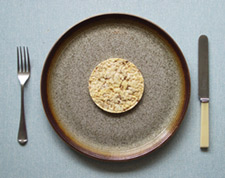 I was scanning a menu yesterday, trying to decide whether it was worth chancing the restaurant, and it made me think about the time I went out for lunch and found there was nothing I could eat. Not a single gf item on
the menu. Not even a potato. So I nibbled a packet of crisps whilst the others tucked in, but even the crisps were ones I wouldn't usually eat as they had a scary warning on the back. I pretended I’d had a large breakfast and wasn't hungry, whilst my tummy rumbled and two large plates of the most delicious-looking fat chips arrived at our table. God I was grumpy.
It’s made me aware of the coeliac’s tool kit. That’s a mental one as well as physical. Because if not making a fuss is your default mode, you need to develop a thick skin. (Good acting skills come in handy too, though I doubt any of my friends ever actually believe me when I claim I’m not hungry.)
Asking the waitress to bring a catering-size tub of stock powder to the table so you can look at the ingredients because the chef can’t tell if it contains gluten isn’t the way to endear yourself to your fellow diners, but if it’s the only way you can safely eat, you just have to get on and do it.
Another requisite item is a pretty big handbag. Somewhere to stash your emergency supply of food. Sandwiches, snack bars, fruit…that sort of thing. Maybe even some of last night’s stir-fry.
At Caffé Néro I frequently ask, ‘Do you mind if I eat my own lunch in here? I can’t survive on chocolate brownies’. So far nobody’s twigged that a customer regularly eating their own lunch from a Tupperware box is a lost order, and I’m happy to continue until they do.
You need a pair of magnifying glasses for the tool kit because, no matter how good your eyes are, you’ll struggle to read the microscopic print on most packaged food. Try reading the back of a Magnum in the darkness of a newsagent’s. It is always best to read the label, although it didn’t prevent me once eating the roll in a gf meal which was clearly labelled ‘ALLERGEN: wheat’ because for some obscure reason I thought it was a special bread roll for those WITH an allergy to wheat.
Crazy, I know, but it just shows how you need to keep your wits about you in a world that seems determined to make you ill.
It’s difficult when we place such store on food not to be disappointed when our desires are not met and everyone else is happily tucking into the object of theirs. Sometimes it’s hard to remember it is just grub.
8th March 2014
Being diagnosed with coeliac disease
I love jacket potatoes, but not every day. My record is five on the trot. That was five meals on holiday in Wales when the only thing I could eat was a jacket potato. At the sixth I didn’t even get that. My supper of frozen peas and carrots (yes, honestly) made me laugh because it was so spectacularly bad. Especially as it was a gastro pub and we’d walked 4 miles along the coast to get there. Even their mashed potato had flour in it. And to cap it all, on an evening like that, you can’t even drown your sorrows in beer, because guess what? You can’t drink the beer either.
I was diagnosed with coeliac disease in 2007, the day before I left for a two-month job in Lithuania. I thought that the weird upsetting world in which I found myself where I could no longer eat anything normal would eventually go away, but it didn’t. I survived on buckwheat, picked off the batter from fried fish and occasionally cried. But not into my beer.
Sometimes, as in my case, it takes years to be diagnosed with CD but the minute you know you have it you can start to get well again. OK, it’s a nuisance, and you might occasionally weep with the misery of it all, but in my book it’s the best autoimmune disease to have as it’s relieved by diet. And as long as you like jacket potatoes you’ll be fine.
Now is an excellent time to be diagnosed. It might not seem so when the safe, ordinary world you inhabit suddenly ends and is replaced by a dangerous one in which a solitary breadcrumb might make you ill, but right now free-from food is the fastest growing sector in supermarket sales and there are whole aisles dedicated to food you CAN eat.
Changes in food regulations will soon mean that we’ll be able to find out the ingredients of any unpackaged dish on a deli counter or in a café. Awareness of CD is growing and this, combined with new legislation, means that having the disease is more a minor inconvenience than the life-changer it used to be.
Of course occasionally it is the pits, and you end up pretending that you really do just want a packet of crisps for supper in the pub, but last week I actually met a waitress who not only knew the ingredients in every dish but even volunteered, ‘the dressing does have a bit of soy sauce in it, but we can make one without if you’d like.’
Although CD is diagnosed quite simply, it can be tempting not to bother. After all it seems pretty easy to cut out wheat from your diet. But there are two reasons why having a diagnosis is important. The first is that removing a major food group has large dietary implications that are not always beneficial; secondly coeliacs are at risk from other conditions as well and these can compromise future health. A diagnosed coeliac will be screened for them. Someone who just gives up gluten won’t, so you’ll be missing out on a lot of medical expertise you might need some day.
Just something to mull over whilst you’re eating your potato...
Information on this site is not a substitute for medical advice and no liability can be assumed for its use.
If you experience any problems with this website, please contact the webmaster.
|